CURA's Charts and CurAstro4 Analysis
by Patrice Guinard, PhD
The Greeks have taken over, systematised, transfigured, and also abused the ancient techniques of Mesopotamian astrology, through the Jewish and Alexandrine circles later on called hermeticist, which have shaped the base of superstitious astrology that spread on papyrus, parchment, and paper, then in modern editorial shops and on the Internet in 2015. In Mesopotamia and elsewhere, until the oldest proto-astrological models, one did not care about individual birth charts. What was the point, except for a few exceptions? They would draw up collective charts, or more exactly lists of data for use by the sovereign and drawn up for the kingdom or for a region. The individual was of little importance, and had to remain so, but for a few exceptions.
The individual birth chart has hardly evolved in a few millennia, and it is quite easy for anti-astrologers to smile about this matter. Adding a few planets to the chart was manageable. The introduction of Uranus, then Neptune and the other planets, has not fundamentally called into question the usual techniques of the astrologers. But the 8 HOUSES was an explosion within their consensual, trivialised, and sterilised toolkit, it is an epistemological break which few are fit to experiment. Because taking into account the 8 HOUSES implies that all the findings and techniques of modern astrology, as well as of ancient astrology since the Greek, are false and obsolete. The common astrologer, who has learned astrology in manuals, is unable to challenge not only his usual practice, but above all the image he built of himself when the astrological representations have started crystallising in his consciousness. This paper is not aimed at the old short-sighted persons, nor at the young lightless conformist people, but to those who are ready and able to make the leap toward tomorrow's astrology.
Because there is little change in astrology, little questioning, no good judgement, no research spirit, and even less intellectual probity. I'm not speaking here of those drawing predictions, of the chart makers in consulting rooms (I leave them to the delights of sociologists) but of the astrologers or so-called astrologers, those who attire themselves in some historic or astrometric baggage : sheep-like people for the most, conformists, salmeschoiniakians, retarded Petosiris and dressed up Valens (0), bastard lillysts or morinians, kochians or placidians for the least ignorant among them. Some collect antique and medieval recipes and stuff the chart with lots, parts, and nodes; others gather the debris of a multitude of planetoids or bizarre hypothetical planets to sprinkle it. Whether they look back to the past or forward to the astronomical present and future, they don't see anything, they don't feel anything, and imagine that mixing the debris of mythology, Jungian or Lacanian scrap, hermeneutic rogatons, and stuffing pages of chit-chat and interpretation with it, is doing astrological work!
Their charts look like them and look alike : they are ugly, incoherent, overloaded with useless frivolities, false, conceived in the same factories, fed from the same mangers. Because currently there is no astrology software (free or charged) which in my eyes can propose a name worthy chart. Overall the distribution of colours is non-existent, random or lapsed (like the one assuming an analogy of nature between signs in Trine, the supposed Water, Earth, Fire, and Air signs). The Houses are false and corrupt : twelve-house systems organised in the opposite direction to the daily movement (so-called Porphyrius, Alcabitius, Meridian, Campanus, Regiomontanus, Placidus, Morinus, Koch, Topocentric, Equal Houses, among others), so that all planets retrograde during the day, passing from House XII to XI, then to X, to IX, and so on. The Medium Coeli is wrong when it is not perpendicular to the Ascendant; since it is only a calculated ecliptic point, updated in the future, without link to the moment's chart and which is not really in the 'center of the sky' but next to it. The planetary operators are contingent, chosen randomly and without even semblance of justification or questioning on the reasons of the choice. Finally, the planetary altitude is ignored, so that planets close to the horizon are sometimes found above the Ascendant though they have not risen, or inversely: planets already risen are represented under the Ascendant in the chart. Same thing with Descendant and worse with high latitude charts.
The charts presented here, and the chart reports (CurAstro4), are set up using available tools and synthesize all the criteria necessary for their evaluation.
THE ZODIAC
The tropical zodiac (1), (2), (3) : which means based on the intersections of the celestial ecliptic and equator, which form the limits of four zones, each divided in three sectors. For the Sun, they are the seasons. The justification for the division of the zodiacal quarts in three signs correlates with the division of the four seasons in three months. The so-called sidereal zodiac is a modern concept of degenerated astrologers. The fact that stars and constellations have served as reference to antiquity's astronomers and astrologers, does not imply that they used a sidereal zodiac, especially during a period when signs and constellations coincided, precisely the period when the astrological zodiac has been developed (4, in FR) !
PLANETS, POSITIONS, AND ASPECTS
Medium Coeli (MC) : orthogonal to the Ascendant (AS), as mentioned earlier (5). The planetary positions : topocentric rather than geocentric, with the additional indication of the planetary position below or above the horizon, depending on the real altitude of the bodies. A positioning relative to the centre of the earth makes no sense. In fact the parallax, which is the deviation between the topocentric and geocentric positions of a planetary body, is only significant for the Moon, the more so as it comes closer to the horizon.
The real planetary aspects, limited to the four major aspects (6, in FR) and to the synergic figures they create : the Cross, the large Triangle, the semi-Square (7). In reality, other figures should be taken into account depending on the harmonic connection that the planets maintain : the Stellium (from four planets in conjunction with each other), the Kites (the major of which adds a fourth planet in double sextile to a large Triangle), the Rectangles, among which the mystic Rectangle (four planets connected by two sextiles and two trines), the Yod (three planets connected by a sextile and two quincunxes) and the Spikes, the Pentagram or Large Quintile (five planets connected by quintiles of 72°), the major Heptagon (seven planets connected by heptiles of approx. 51°27'), the Large Octile or Octagon (eight planets connected by octiles of 45°), the Enneagon (nine planets connected by noviles of 40°), the Decagon, and so on. The charts are drawn with the figures (more than 200). The minor 'aspects', which belong firstly to the synergic figures, are indicated in dotted lines (see the chart of November 8, 2003.
PLANETS, COLOURS, AND RULERS
The twelve planetary bodies (giant planets, dwarf planets, or planetoids) finally include Pluto, Ceres and Chiron, and since the astronomers do not want to hear it : it is not a matter of diameter, but of frequency, of rhythm, of return and progression on the ecliptic or close to the ecliptic (8), (9), (10).
These twelve operators form a structured whole equipotent with the zodiac, in other words they coincide with the zodiac signs : one planet for each sign. This coherence between the planetary and zodiacal palettes, is illustrated by what the Greeks used to call Domiciles. The idea of Domiciles, before becoming a superstitious practice (the assumed Master of the Ascendant which is the planet corresponding to the zodiac sign of the Ascendant, and whose position in the Zodiac one studies indirectly, or worse in the puppet canvas of the 12 Houses), was an attempt to harmonise the planetary and zodiacal operators. The Greeks have failed with an insufficient Septenary, as Képler did in his attempt to harmonise the spheres. For each zodiac sign, one planet, and one colour (11, and see the French revised version : FR) :
Aries Mars Red Taurus Uranus Blue Gemini Jupiter Orange Cancer Moon White Leo Sun Yellow Virgo Venus Green
Libra Neptune Violet Scorpio Pluto Black Sagittarius Chiron Pink Capricorn Saturn Grey Aquarius Mercury Brown Pisces Ceres Turquoise
THE 8 HOUSES
"There will be no revival, as long as astrology is invaded by lobotomised retarded, by empty-headed idiots who can only see their small person and interests, who have not developed any single ounce of spirituality, who are fooled night and day by media noise, consensual idiocy, chatter of charlatans, crooks and corrupters, who go and sniff at astrology matters in contact with journalists, pseudo-scientists, wikipedists, and regurgigate their catechism on cheap forums, on soporific horoscopy sites, on henhouse astrodemagoguery associations and federations." (see I.V.2015)
The 8 Houses, the only real coherent reference of the movement of the local sphere, cut into average slices of three hours, independently of their zodiacal reference and of the length of the diurnal and nocturnal planetary arches (12), (13), (14). The supposed system of the 12 Houses is a late system, reproducing the zodiac, and submitted to the zodiac. My concept of Houses (from the octotopos to the octotropos, initially called Dominion, and as of now OCTOTOPE) has been criticised across the Atlantic by a few desperate hermetic people who contested its weak historic grounds. On this point one can rule in their favour, as documents lack (but what remains of the first Greek astrology? And what do they do with Manilius, whose models are incompatible with those of his contemporaries?) : it remains that this logical and coherent, and especially efficient concept of the astrological organisation of the local sphere and the daily time, is not linked to this historical background, the same way it is not linked to the works of Cyril Fagan who has understood and mentioned the incoherence of the duodenary system but did not use the eight house system (15), but rather results from a reflection on the Gauquelin curves and the so-called SORI conditionalist system (which remain dependent on the Placidus domification method and of its hourly trisection of the semi-diurnal and semi-nocturnal arches).
Moreover, the meaning of the 12 Houses bears no relationship with the activities of the day (and of the night), which should have been its first meaning. The Romans (although the most ancient sources diverge), have divided the calendar day in 8 time frames : 6h mane, 9h ortus, 12h meridies, 15h occasus, 18h vespera, 21h conticinium, 24h intempesta and 3h gallicinium (the hour when the rooster starts expressing himself). This division applies to the organisation of military camps, and it will be adapted by the catholic clergy in the organisation of the liturgical offices and of the prayer times, as in monastic life : around 6h Prime, 9h Terce, 12h Sext, 15h None, 18h Vesper, 21h Complies, 24h Vigiles, 3h Laudes. It corresponds to the Greek "okto hora" (the division of time in eight), or to the Latin "octo horae", the eight hours.
The division in eight is also well linked to the immediate surroundings and to its natural division, to spatial orientation : the eight directions of the wind rose, used by compasses and in navigation. They are the "okto topoï » of the Greeks, the eight surrounding spaces. I emphasized the primacy of spatial on temporal conditioning with regard to the meaning one should give to the so-called Houses, i.e. the living locations, which are those of the spirit and consciousness.
These "locations" are not in heaven or on earth, but in human perception : the Houses inform about the quality and the methods of apprehending relational space by consciousness. In that sense, they are less "topos" than "tropos" (manner, method). I gave them barbaric names and added more illustrative terms : I diurnal Objectivation (Communication), II diurnal Alligation (Friendship), III diurnal Individuation (Situation), IV diurnal Participation (Harmony), etc.
CURASTRO4 PROGRAM
The program of hierarchisation of the astrological operators synthesizes the main elements of the analysis of a chart. It is a kind of notebook, preceding the interpretation exercise. It groups the main aspects (the conjunctions to the Desc and IC are marked as oppositions to the Asc and to the MC : only the "conjunction" of planets with the Angles (i.e. their presence) exists, the rulers in Signs and in Houses (and which in the first place and above all indicate an intensification of the concerned elements : 16 ; 17), the dominant planets, signs, and houses (on average four to five planets, two to three signs and one or two houses, i.e. one third of the operators), and finally a tetradic distribution of the general tendencies of the individualised chart. From these elements one can reconstruct a second theme, a derived theme, taking into account only the main elements, namely planetary and sectorial (see infra Ficino's double chart).
All the images (charts and CurAstro4 report) can be clicked on and are accessible as a glimpse and by transparency. Links are provided for studied authors and notabilities at CURA.
My already old (1983-1998) program Astroléade has been anglicised and renamed CurAstro4 in February 2016 (abbreviated CA4 infra).
1. SCIENCE, MATHEMATICS
Nicolaus Copernicus (1473) ⇒ Garcaeus⇒ BSB 27003
⇒ chart

Georg Joachim Rheticus (1514) ⇒ Gugler ; chart
Tycho Brahe (1546) ⇒ chart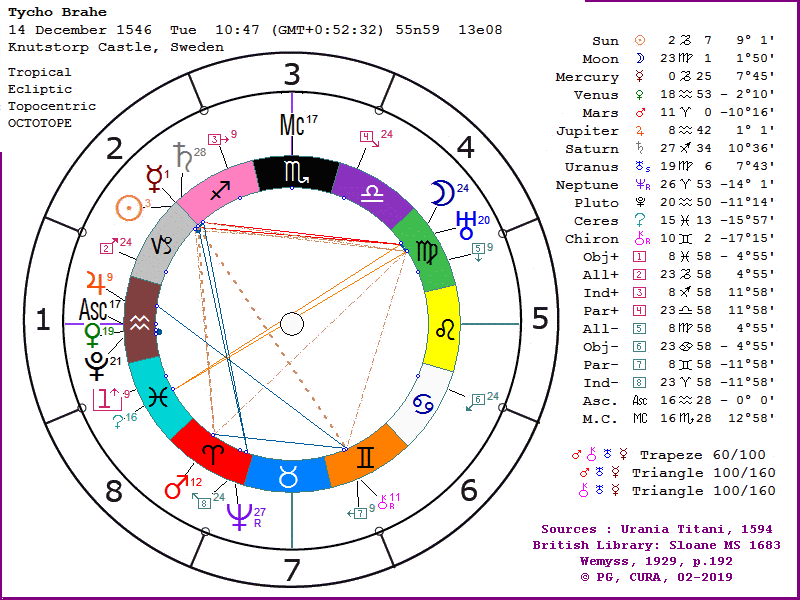
Galileo Galilei (1564) ⇒ Manuscript ; chart⇒ CA4
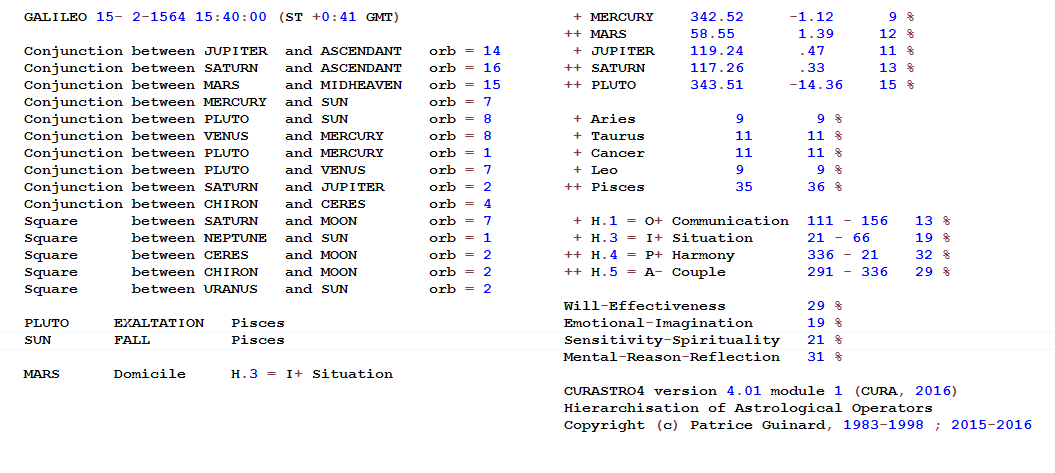
Johannes Kepler (1571) ⇒ K's Astrology ; Réforme ; chart (14:37)⇒ CA4
; chart (13:07)
⇒ CA4
; chart (rectif.)
⇒ CA4
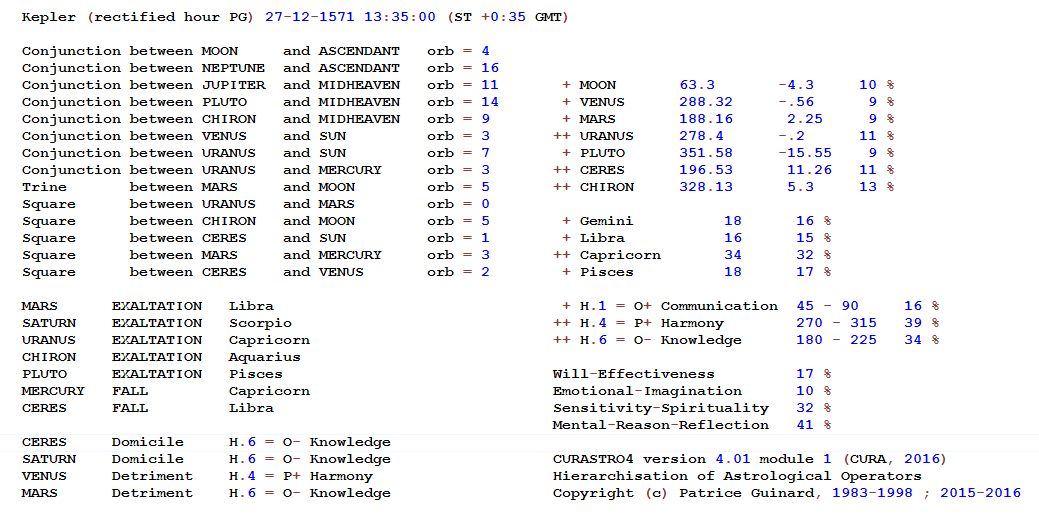
Isaac Newton (1642) ⇒ chart
Georges Cuvier (1769) ⇒ chart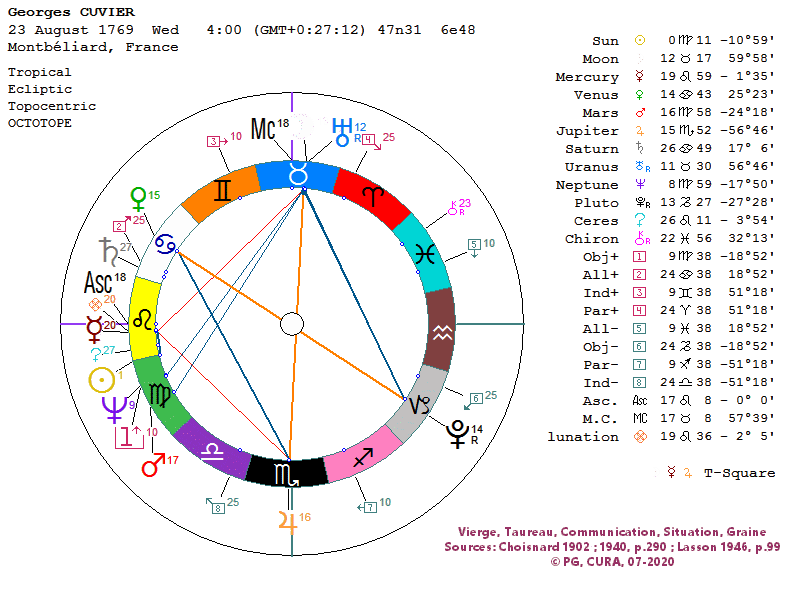
Charles Darwin (1809) ⇒ chart
Évariste Galois (1811) ⇒ Birth certif.⇒ chart
⇒ CA4

Johann Gregor Mendel (1822) ⇒ chart
Dmitri Mendeleiev (1834) ⇒ chart⇒ CA4
; chart Eureka
⇒ CA4

Ivan Pavlov (1849) ⇒ Réflexologie ; chart⇒ CA4

Percy Seymour (1938) ⇒ Magnetism ; chart⇒ CA4

2. PHILOSOPHY, ERUDITION, SPIRITUALITY
Jesus Christus (7 BC) ⇒ Star ; chart
Aelius Aristides (117) ⇒ chart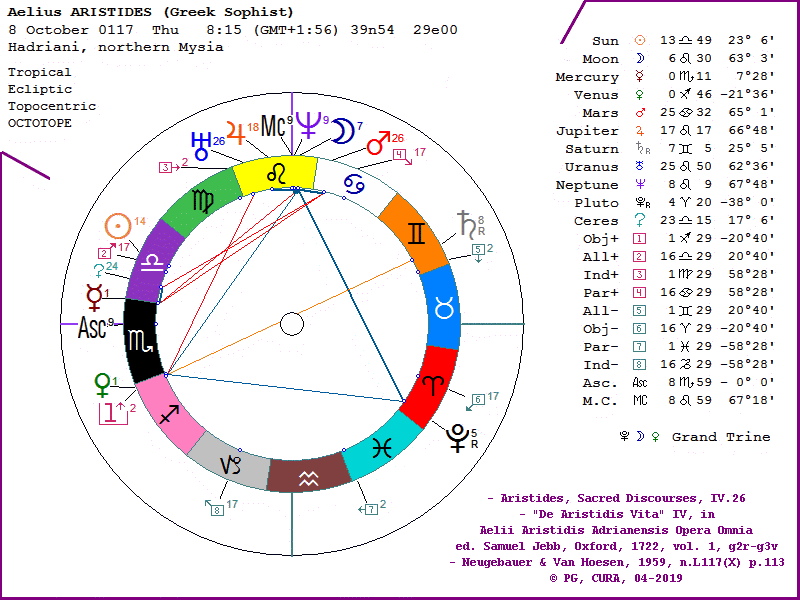
Proclus (412) ⇒ chart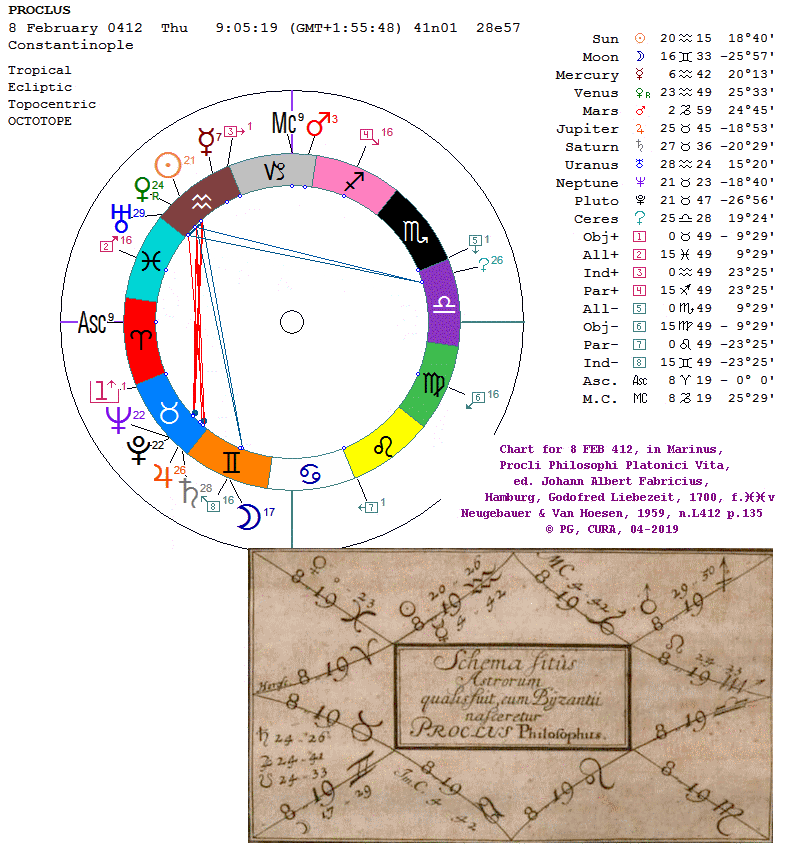
Marsilio Ficino (1433) ⇒ Voss ; chart⇒ Derived chart
⇒ CA4

Girolamo Savonarola (1452) ⇒ MC ; chart⇒ CA4

Niccolo Machiavelli (1469) ⇒ MC ; chart⇒ CA4

Julius Caesar Scaliger (1484) ⇒ della Scala ; chart
Martin Luther (1484) ⇒ Gugler ; chart⇒ alter

Ulrich von Hutten (1488) ⇒ MC ; chart⇒ CA4

Philipp Melanchthon (1497) ⇒ Gugler ; chart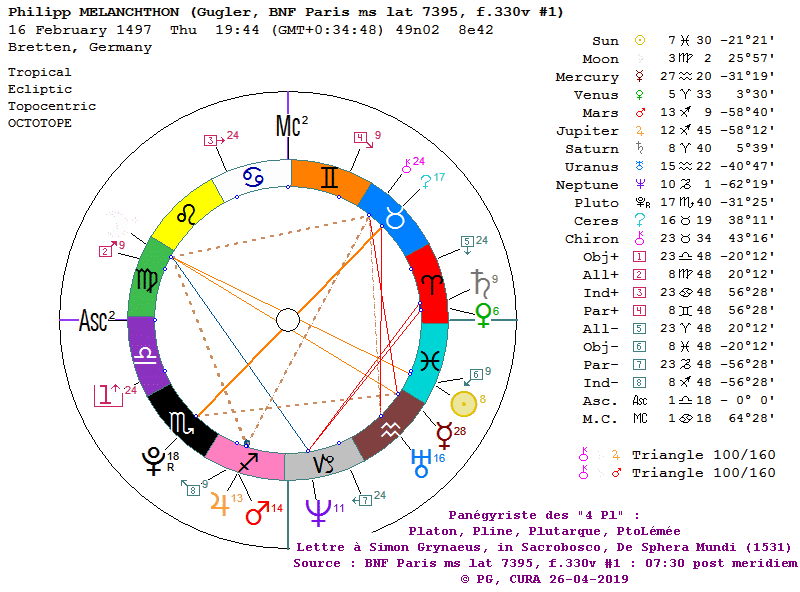
Nostradamus (1503) ⇒ CN 10 ; chart (rectif.)⇒ alter
⇒ CA4
; mors

Tommaso Campanella (1568) ⇒ Sonnets ; chart⇒ CA4

Hugo Grotius (1583) ⇒ chart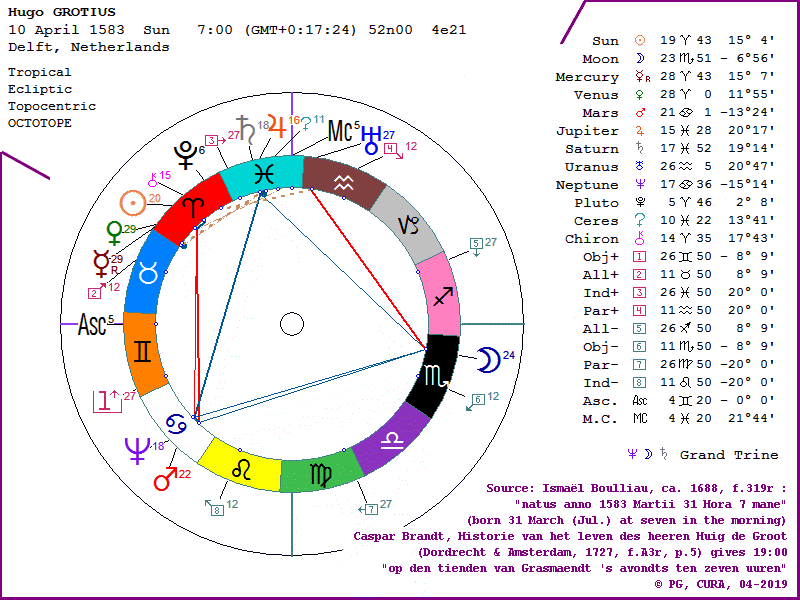
Thomas Hobbes (1588) ⇒ MC ; chart⇒ CA4
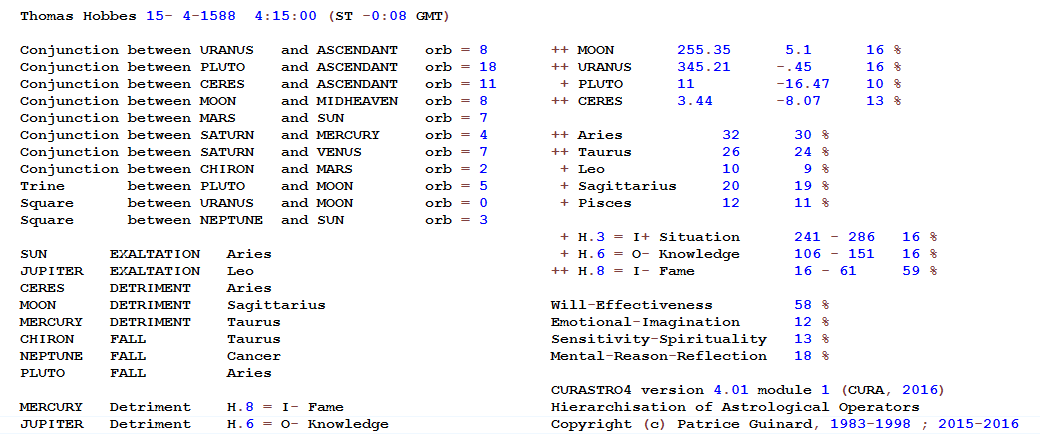
John Aubrey (1626) ⇒ chart
Baruch Spinoza (1632) ⇒ chart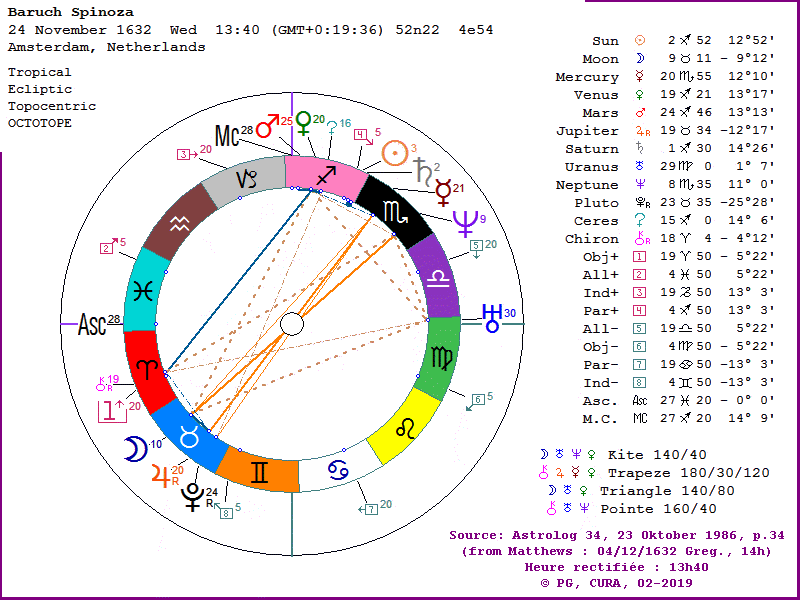
Gottfried Leibniz (1646) ⇒ Psyché ; chart⇒ CA4
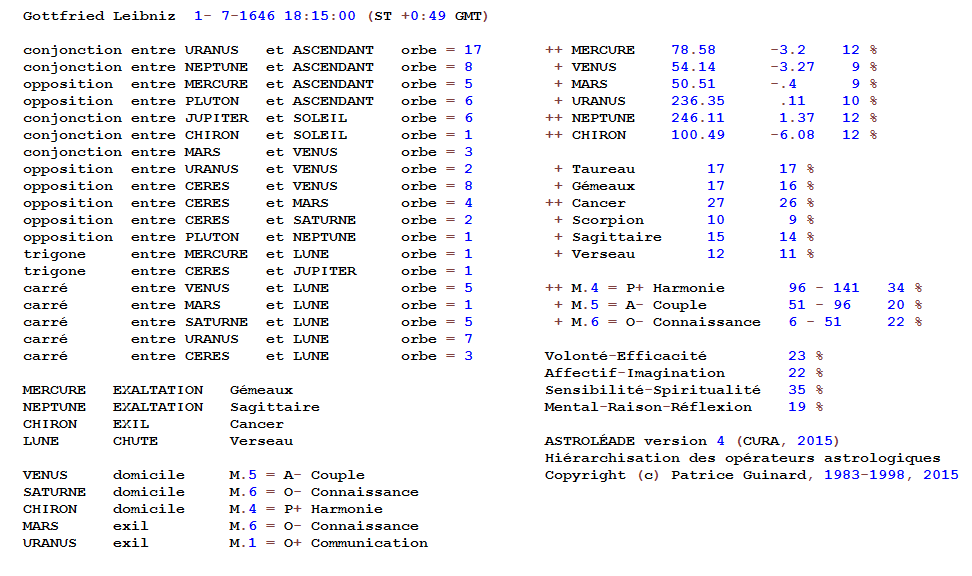
Immanuel Kant (1724) ⇒ MC ; chart⇒ CA4
; chart (rectif.)
⇒ CA4

Henry Paschal, marquis de Rochegude (1741) ⇒ chart
Arthur Schopenhauer (1788) ⇒ chart
Alexis de Tocqueville (1805) ⇒ Démocratie ; chart⇒ CA4
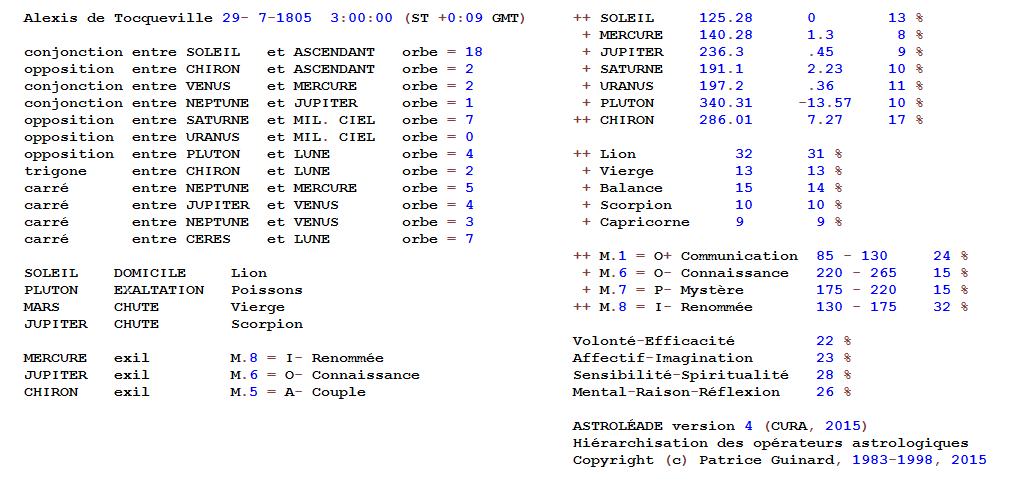
Max Stirner (1806) ⇒ chart⇒ CA4

Eugène Bareste (1814) ⇒ CN 209 ; chart⇒ CA4

Karl Marx (1818) ⇒ MC ; chart⇒ CA4

Henri Torné-Chavigny (1826) ⇒ CN 165 ; Birth certif.⇒ chart
⇒ CA4
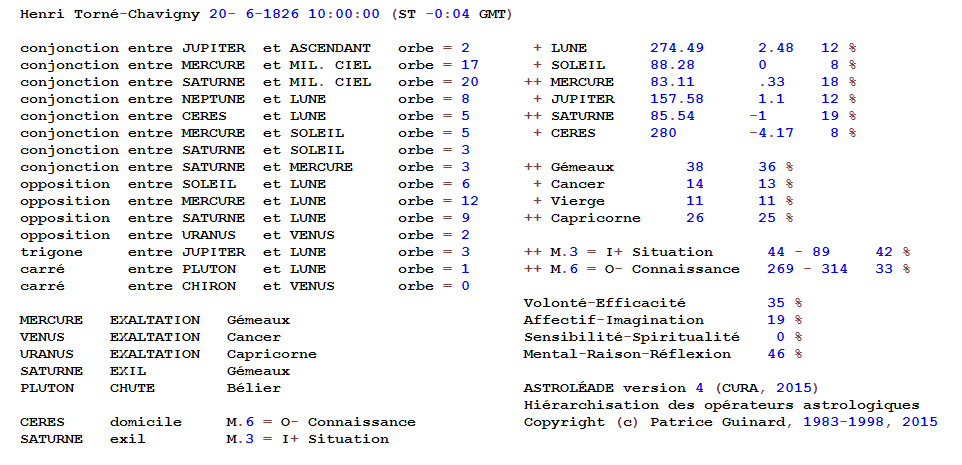
Gustave Le Bon (1841) ⇒ chart
Friedrich Nietzsche (1844) ⇒ Retour ; chart
Sigmund Freud (1856) ⇒ MC ; chart⇒ CA4

Alexandra David-Neel (1868) ⇒ chart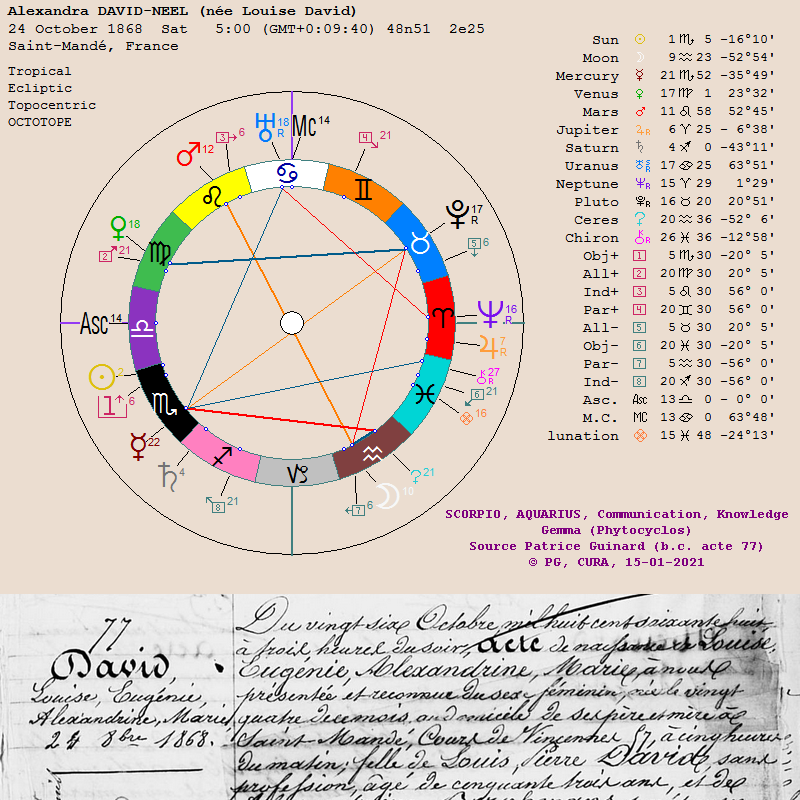
Émile Bréhier (1876) ⇒ MC ; chart⇒ CA4

Hermann von Keyserling (1880) ⇒ chart
Isha Schwaller de Lubicz (1885) ⇒ Birth certif.⇒ chart

René Guénon (1886) ⇒ chart⇒ CA4

René Schwaller de Lubicz (1887) ⇒ Birth certif.⇒ chart
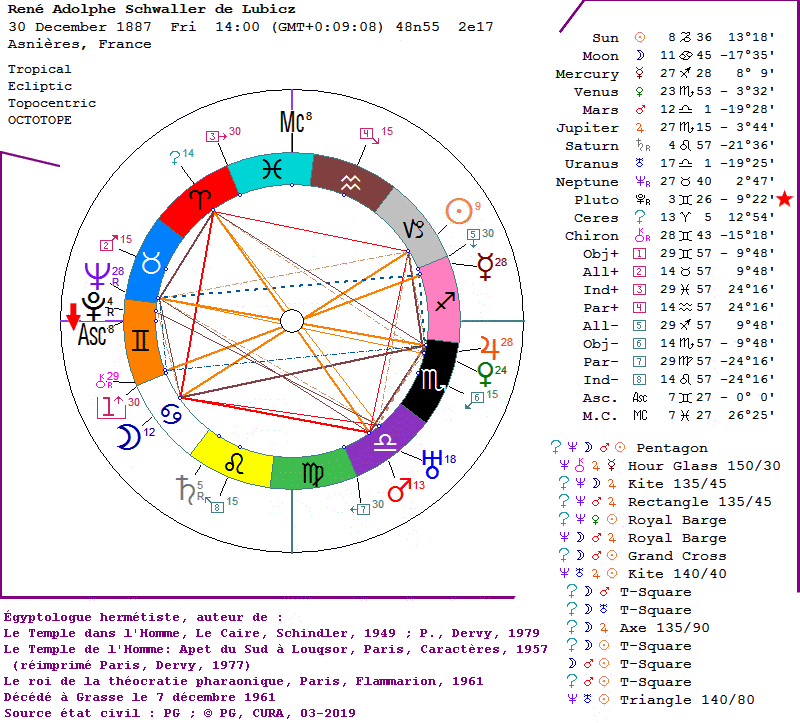
Aldous Huxley (1894) ⇒ chart
Jiddu Krishnamurti (1895) ⇒ Gillman ; Relocalisation ; chart⇒ CA4

Claude Lévi-Strauss (1908) ⇒ chart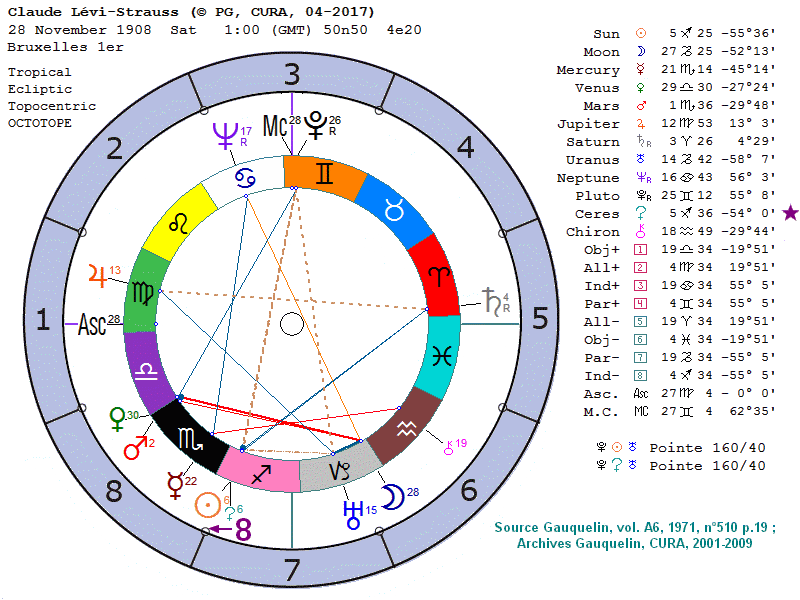
Marija Gimbutas (1921) ⇒ chart⇒ CA4

Gilles Deleuze (1925) ⇒ Abécédaire ; chart⇒ CA4

Carlos Castaneda (1925) ⇒ Birth certif. ; Copy ⇒ chart⇒ CA4
; Relocalisation
⇒ CA4

Jean Baudrillard (1929) ⇒ chart
Guy Debord (1931) ⇒ chart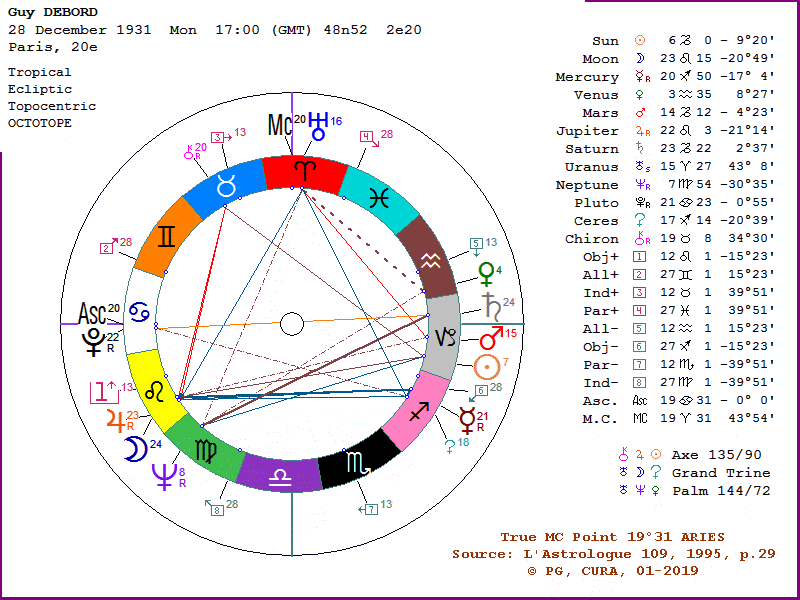
3. ASTROLOGY
Johann Schöner (1477) ⇒ Gugler ; chart
Girolamo Cardano (1501) ⇒ Grafton ; Figura⇒ chart
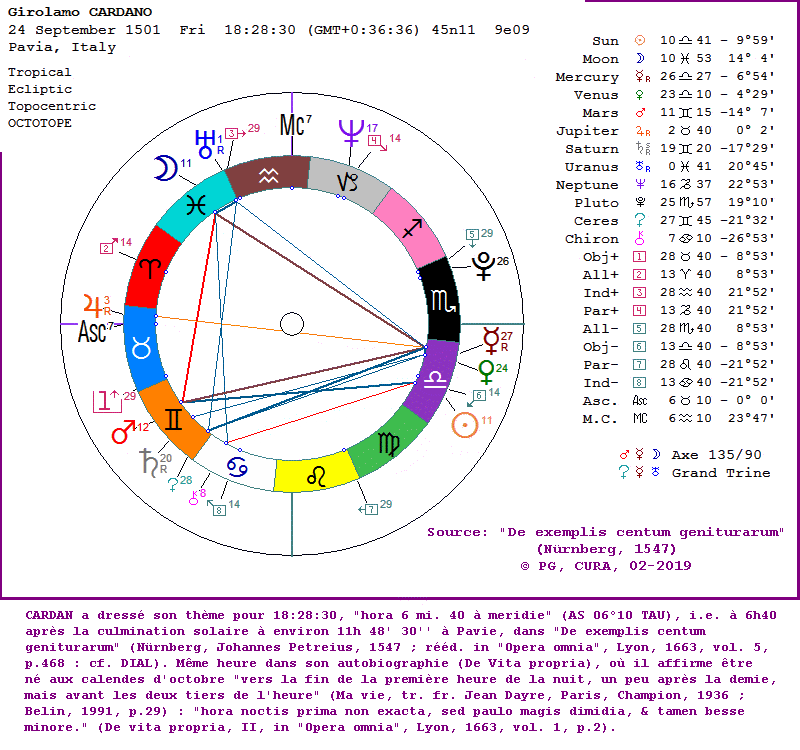
Nicolaus Gugler (1521) ⇒ Gugler ; chart⇒ alter

Cyprian Leowitz (1524) ⇒ DIAL ; chart
Christopher Heydon (1561) ⇒ chart
Jean Baptiste Morin (1583) ⇒ Raitzin ; Figura⇒ chart
⇒ CA4

John Booker (1601) ⇒ chart
Eustache Lenoble (1643) ⇒ Bilan ; chart⇒ CA4

Paul Choisnard (1867) ⇒ Astro20 ; chart⇒ CA4

Dom Néroman (1884) ⇒ Astro20 ; chart⇒ CA4
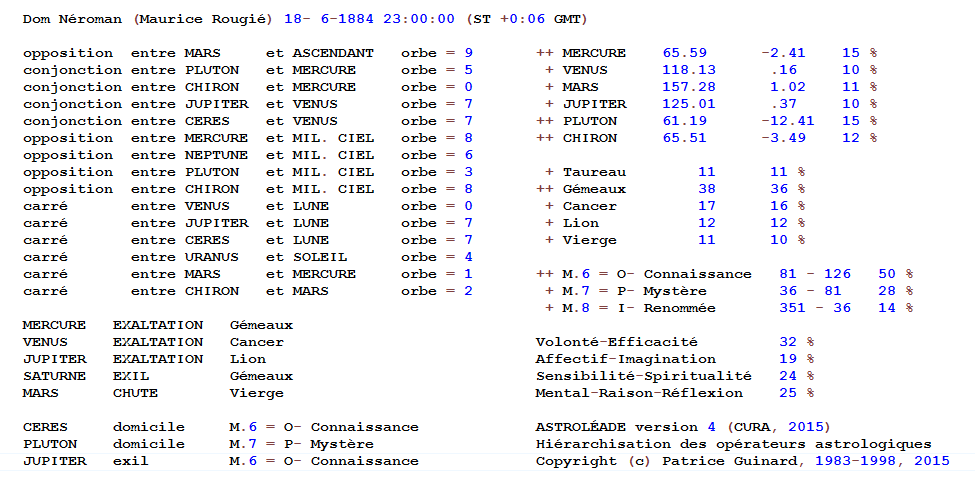
Dane Rudhyar (1895) ⇒ D. Frank ; Birth Certif.⇒ chart
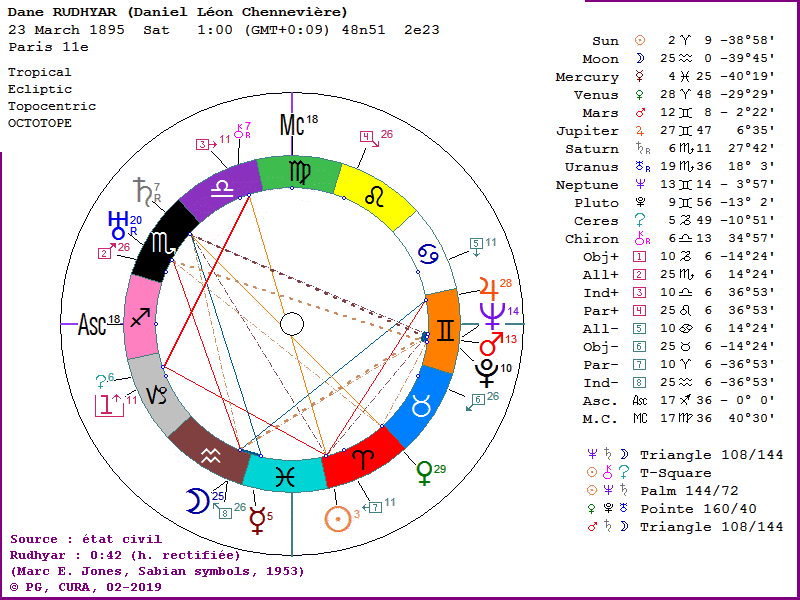
Cyril Fagan (1896) ⇒ Oktotopos ; chart⇒ CA4

Claire Santagostini (1898) ⇒ Astro20 ; chart⇒ CA4

Karl Ernst Krafft (1900) ⇒ Astro20 ; chart⇒ CA4
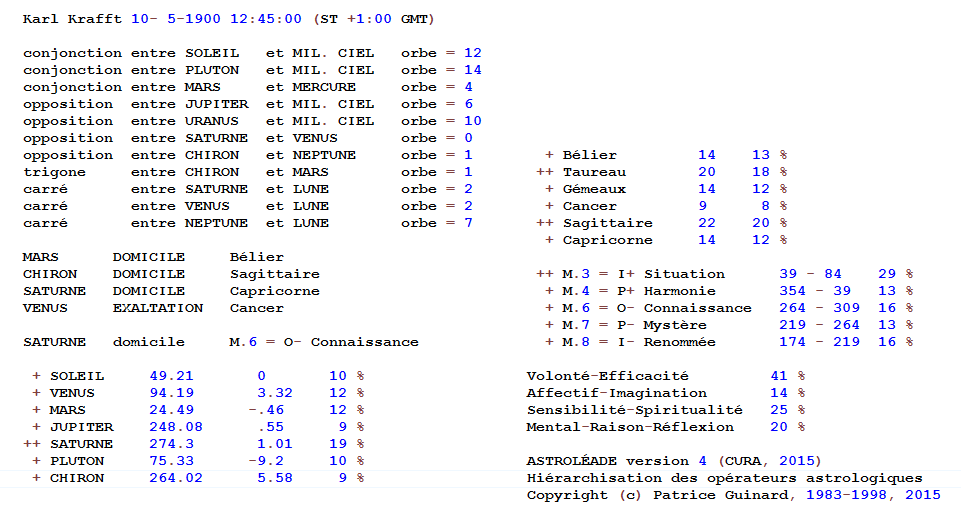
Alexandre Volguine (1903) ⇒ Astro20 ; chart⇒ CA4

Demetrio Santos (1924) ⇒ chart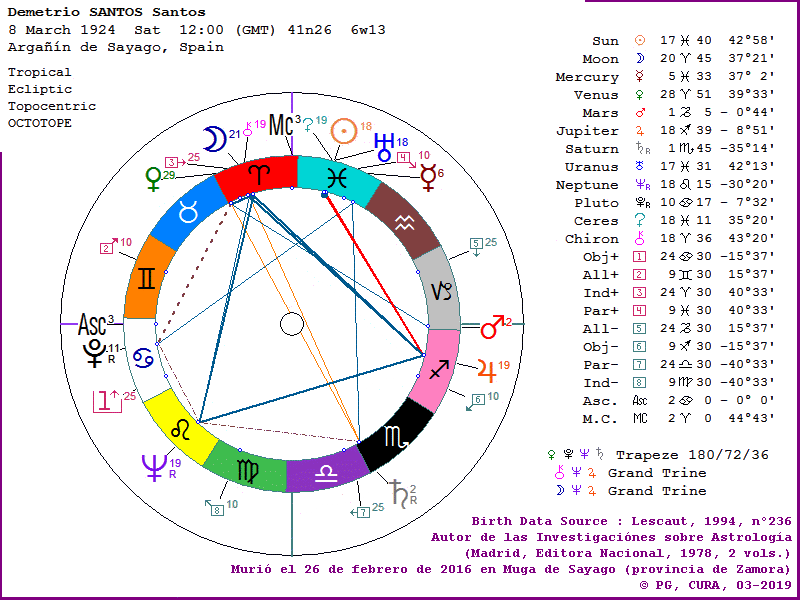
James Holden (1926) ⇒ ArabianA ; chart⇒ CA4

Michel Gauquelin (1928) ⇒ Astro20 ; chart⇒ CA4

Jean-Pierre Nicola (1929) ⇒ Astro20 ; chart⇒ CA4
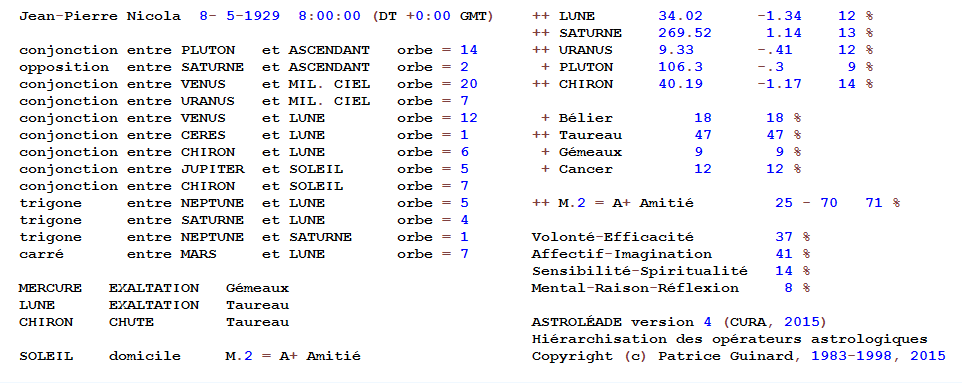
Françoise Schneider-Gauquelin (1929) ⇒ Astro20 ; Clefs ; chart⇒ CA4
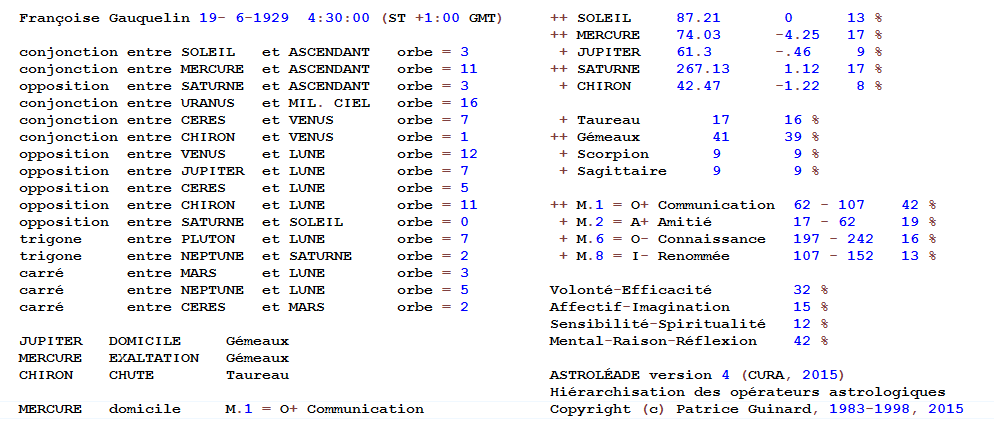
Daniel Verney (1935) ⇒ Astro20 ; chart⇒ CA4

Robert Hand (1942) ⇒ Zodiac ; chart⇒ CA4

Robin Heath (1948) ⇒ Stonehenge ; chart⇒ CA4

4. LITTERATURE
Horace (65 BC) ⇒ chart
Héloïse de Montsoreau (1092) ⇒ chart
Dante Alighieri (1265) ⇒ chart
François Rabelais (1483) ⇒ CN 53 ; chart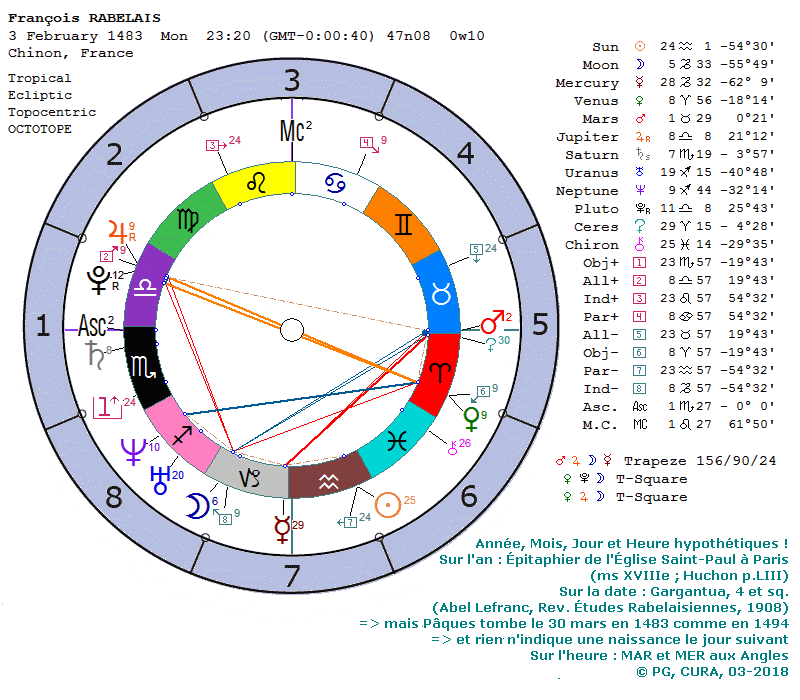
Michel de Montaigne (1533) ⇒ chart⇒ CA4

Miguel de Cervantes (1547) ⇒ chart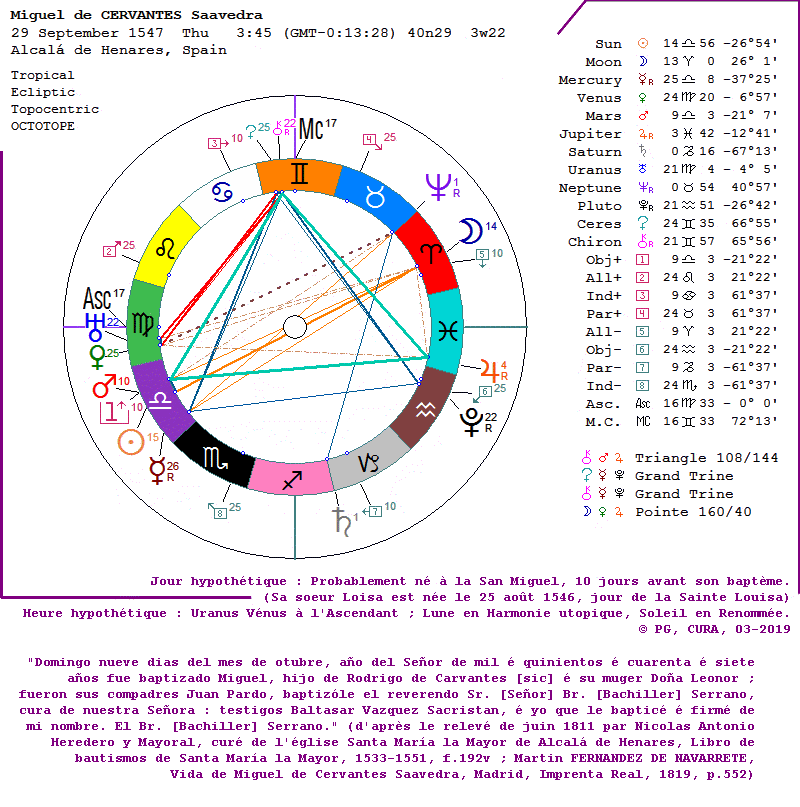
Robert Burton (1577) ⇒ Anatomie ; chart⇒ CA4

La Rochefoucauld (1613) ⇒ chart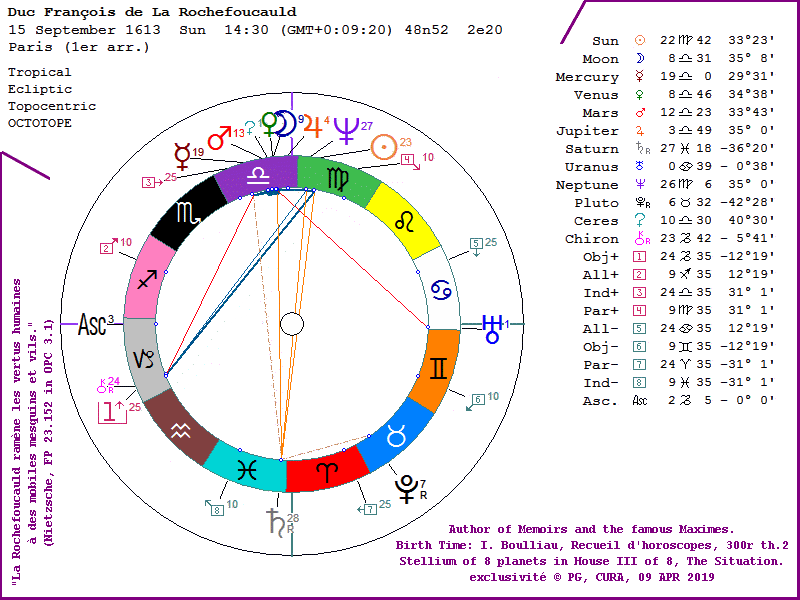
Pierre de Marivaux (1688) ⇒ chart
Johann W. von Goethe (1749) ⇒ TH1993 ; Baptème⇒ chart
⇒ CA4

Friedrich von Schelling (1775) ⇒ chart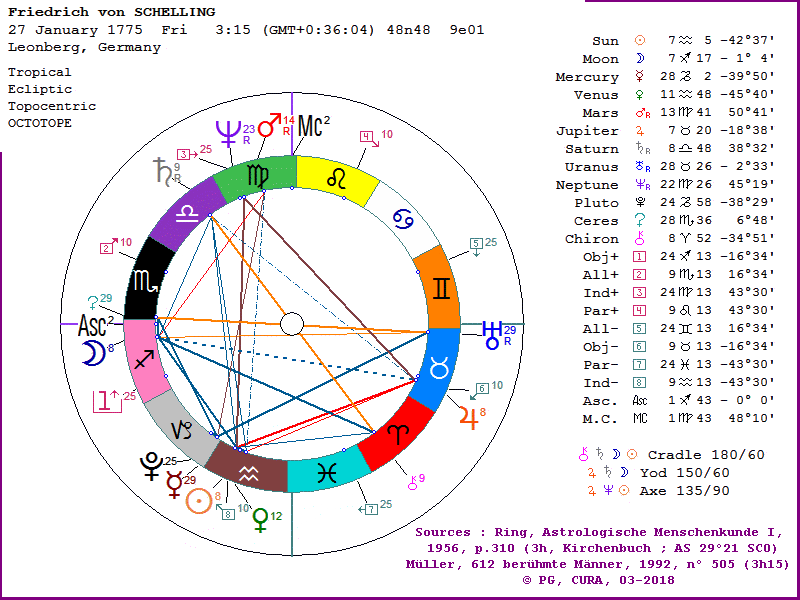
Alexander Pushkin (1799) ⇒ chart⇒ alter

Gérard de Nerval (1808) ⇒ chart
Jules Barbey d'Aurevilly (1808) ⇒ chart⇒ CA4
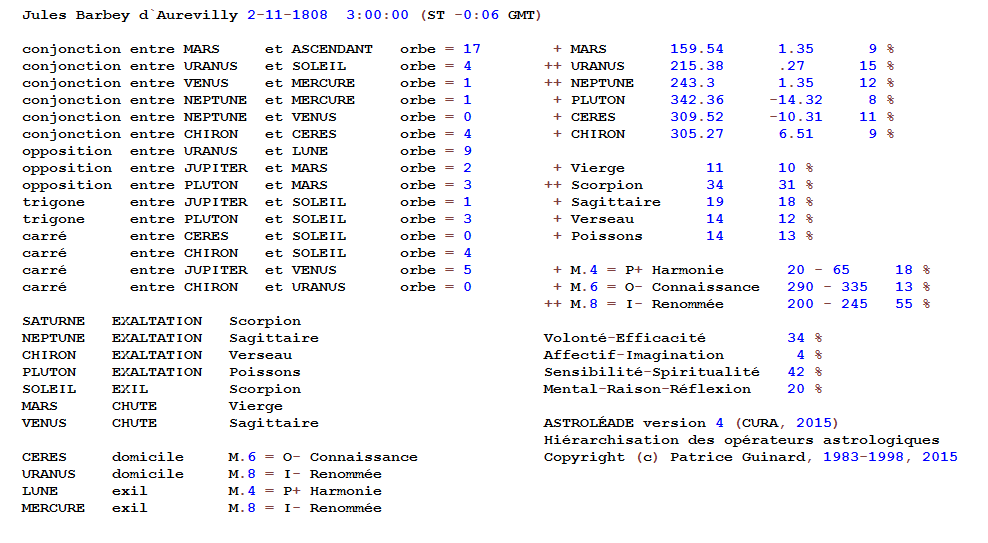
Charles Baudelaire (1821) ⇒ MC ; chart⇒ CA4
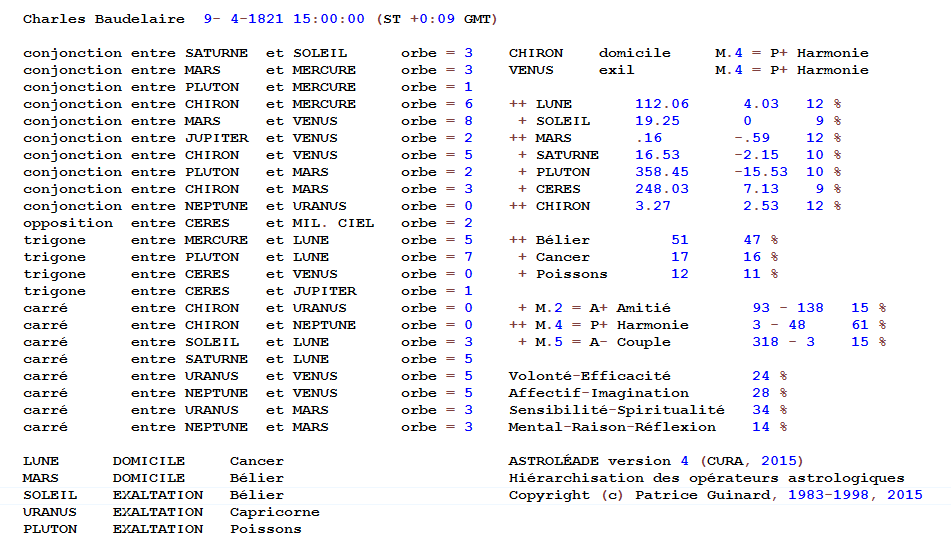
Auguste Villiers de L'Isle-Adam (1838) ⇒ chart⇒ CA4

Stéphane Mallarmé (1842) ⇒ chart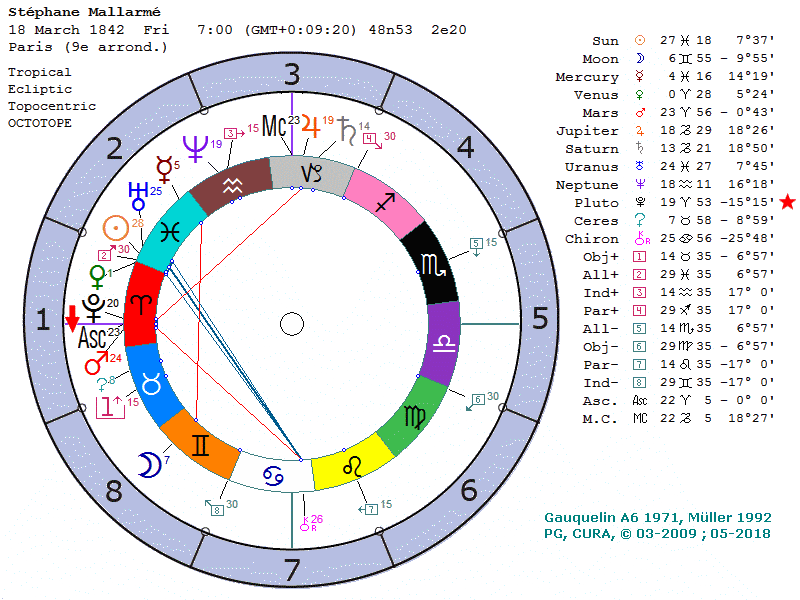
Marcel Proust (1871) ⇒ Cancer ; chart⇒ CA4

Paul Valéry (1871) ⇒ Octotope ; chart⇒ CA4

Robert Musil (1880) ⇒ chart⇒ CA4

Franz Kafka (1883) ⇒ chart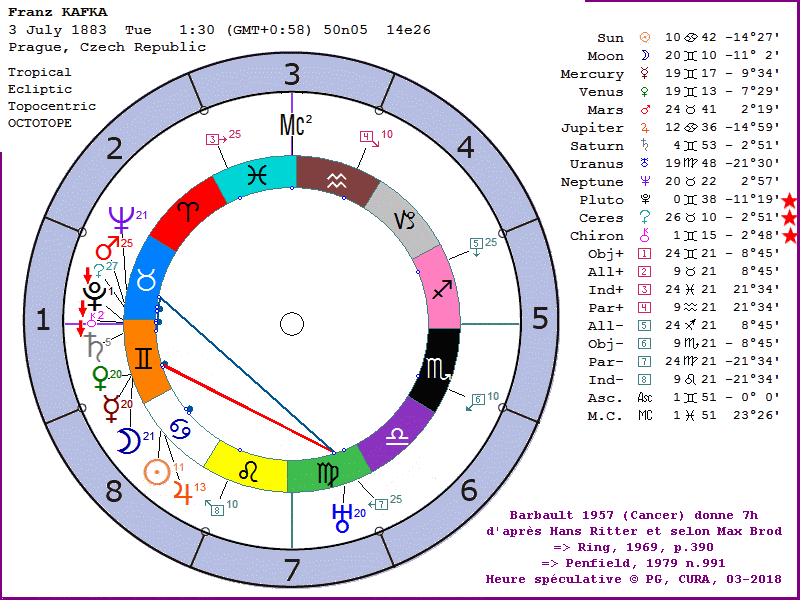
Karen Blixen (1885) ⇒ MC ; chart⇒ CA4
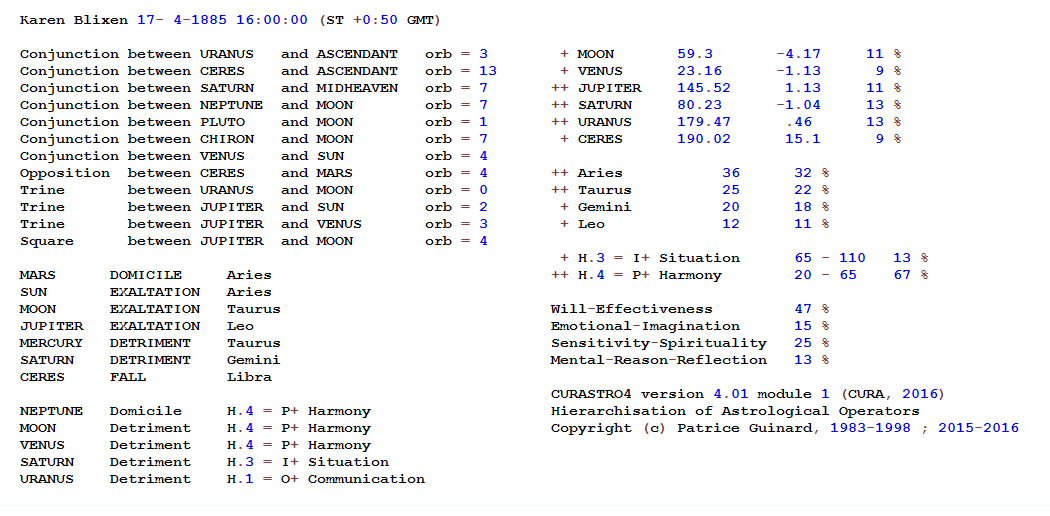
Saint-John Perse (1887) ⇒ Laves ; chart⇒ chart (rectif.)
⇒ CA4

Henry Miller (1891) ⇒ chart⇒ CA4

Louis-Ferdinand Céline (1894) ⇒ chart⇒ CA4
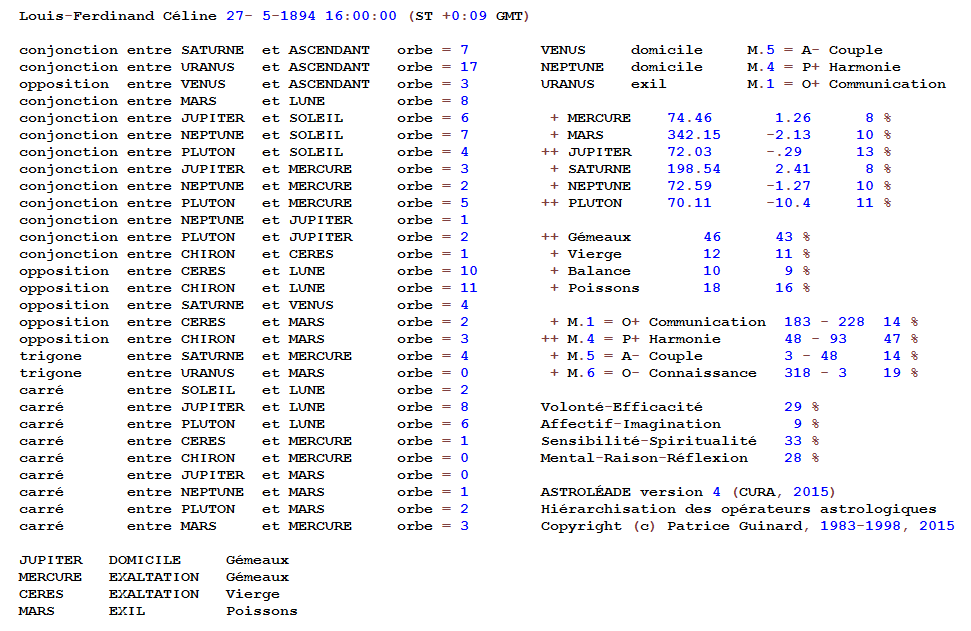
Ernst Jünger (1895) ⇒ chart
Antonin Artaud (1896) ⇒ Birth certif.⇒ chart
⇒ CA4
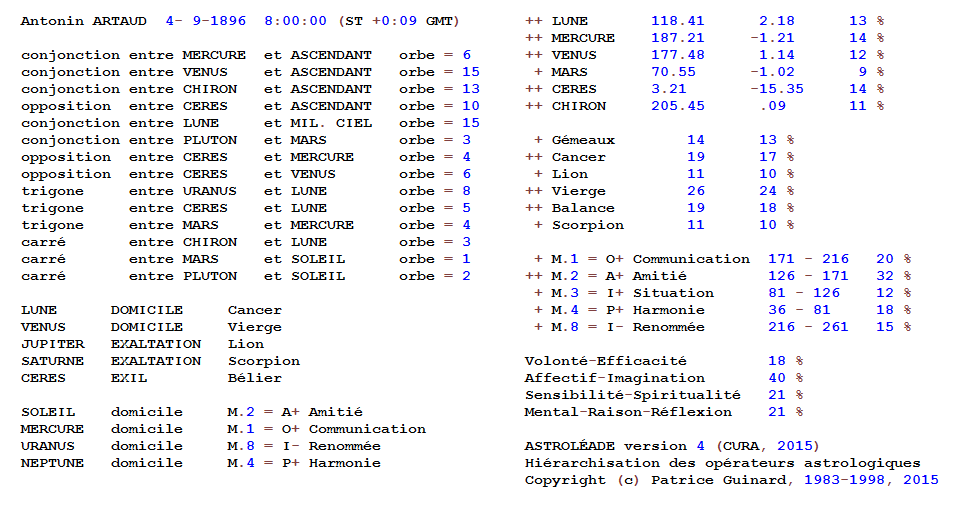
George Orwell (1903) ⇒ chart
Samuel Beckett (1906) ⇒ MC ; chart⇒ CA4
; chart (rectif.)
⇒ CA4
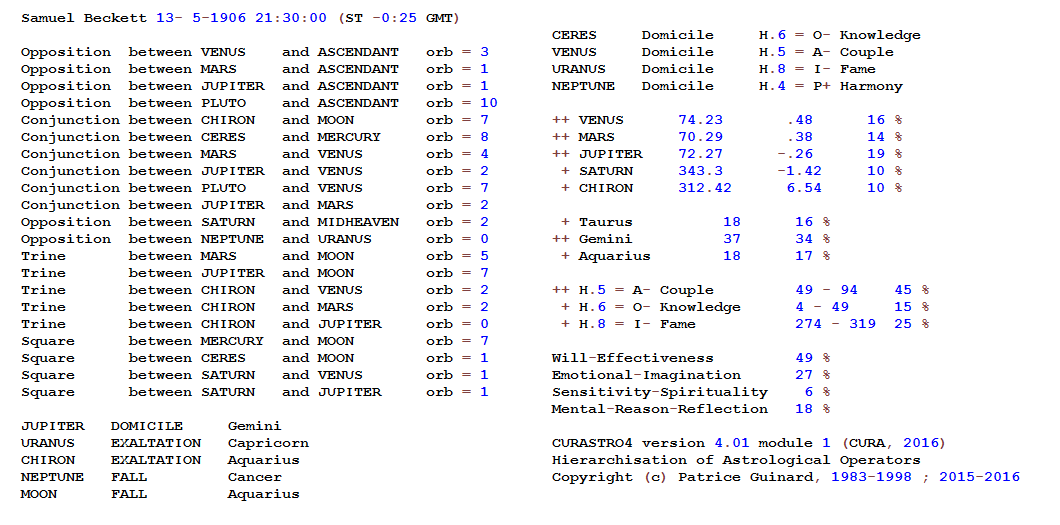
Malcolm Lowry (1909) ⇒ chart
Philip Dick (1928) ⇒ chart⇒ CA4
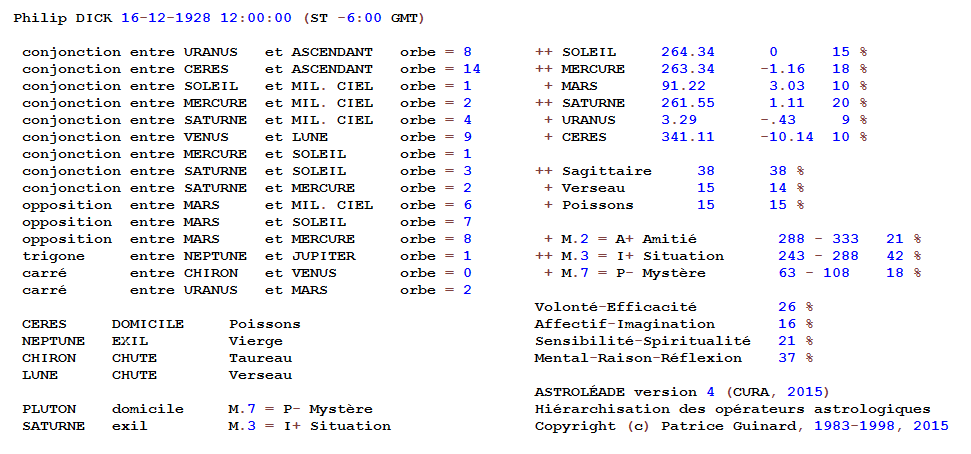
5. FINE ARTS
Leonardo da Vinci (1452) ⇒ MC ; BaBiC⇒ chart
⇒ CA4

Albrecht Dürer (1471) ⇒ Gugler ; chart
Lucas Cranach (1472) ⇒ chart
Raphael (1483) ⇒ chart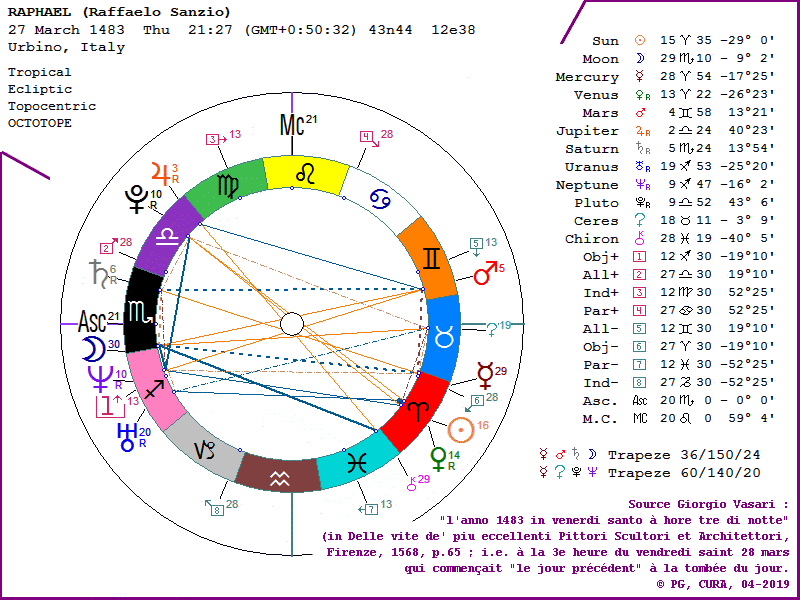
Benvenuto Cellini (1500) ⇒ chart⇒ CA4

Auguste Rodin (1840) ⇒ chart⇒ CA4

Paul Gauguin (1848) ⇒ chart⇒ CA4

6. MUSIC
Carlo Gesualdo (1566) ⇒ chart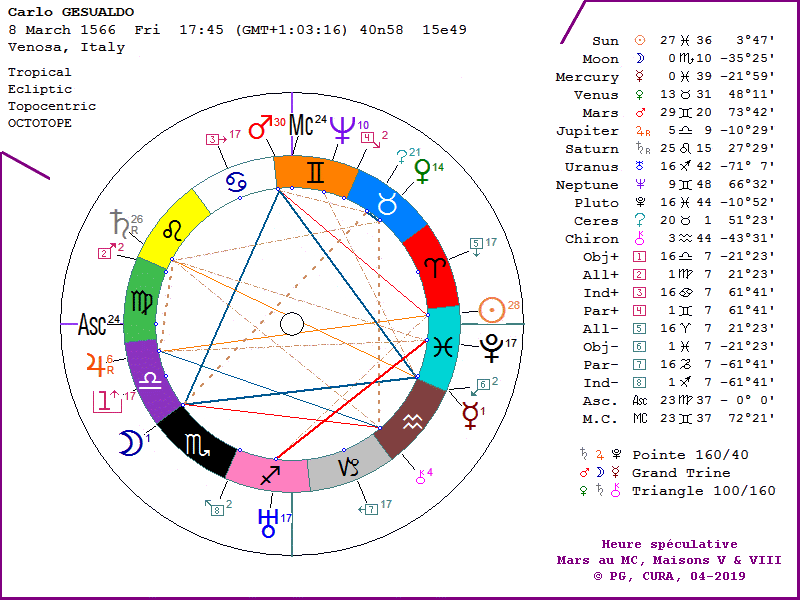
Claudio Monteverdi (1567) ⇒ chart
Henry Purcell (1659) ⇒ chart
François Couperin (1668) ⇒ chart
Antonio Lucio Vivaldi (1678) ⇒ chart
Georg Friedrich Händel (1685) ⇒ chart
Johann Sebastian Bach (1685) ⇒ chart
Giovanni Battista Pergolesi (1710) ⇒ chart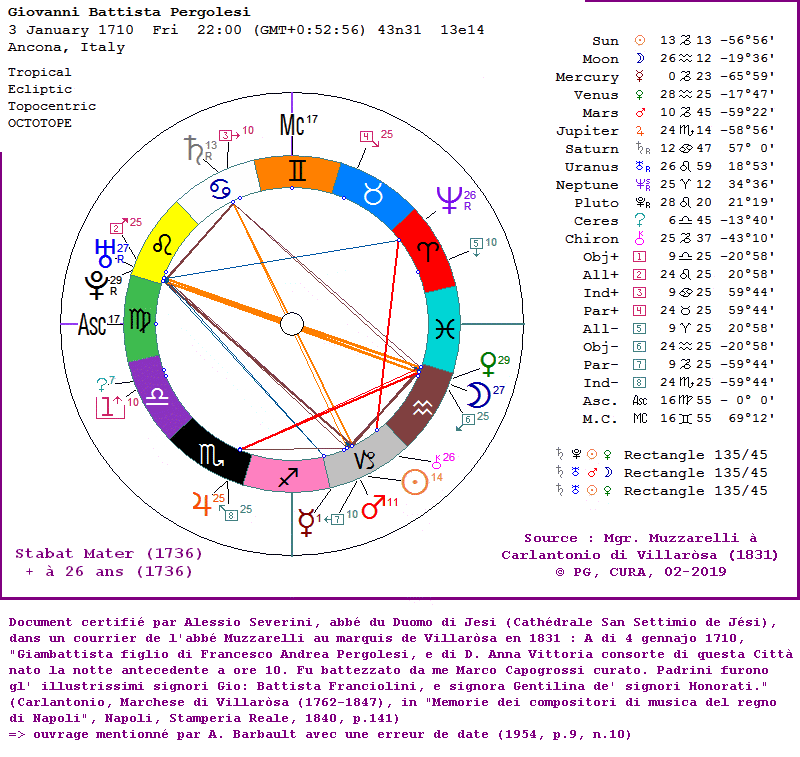
Wolfgang A. Mozart (1756) ⇒ Shelley ; chart⇒ CA4

Ludwig van Beethoven (1770) ⇒ chart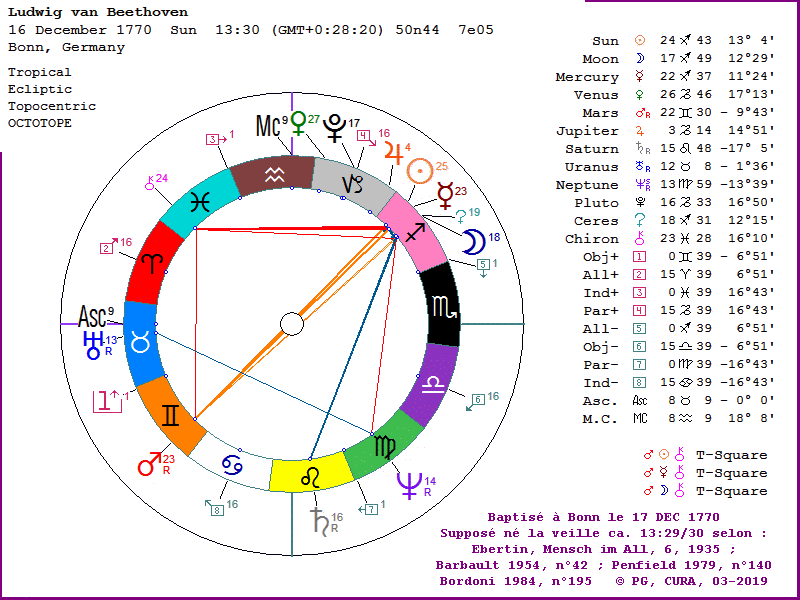
Franz Schubert (1797) ⇒ chart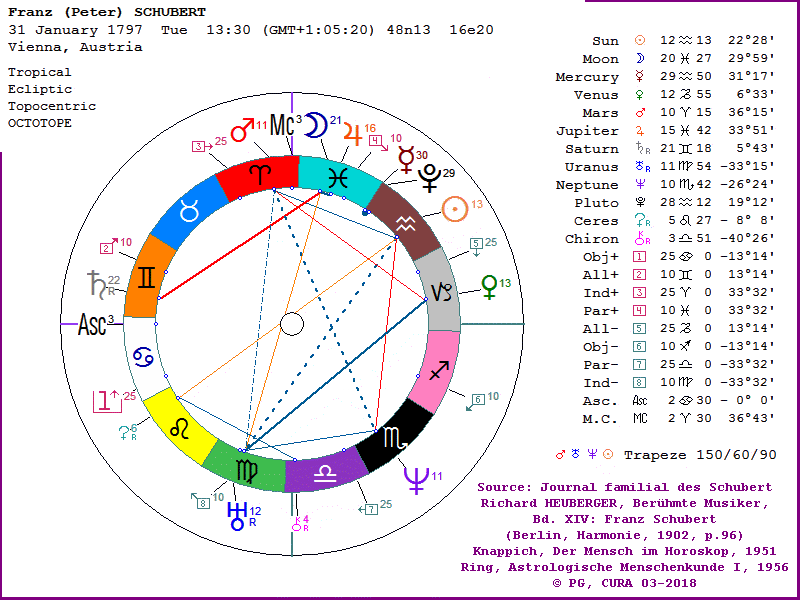
Frédéric Chopin (1810) ⇒ chart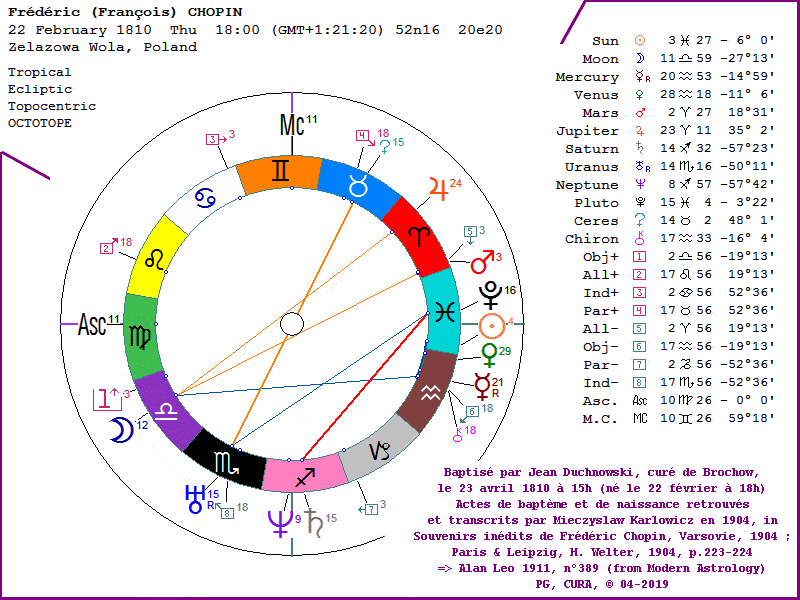
Richard Wagner (1813) ⇒ chart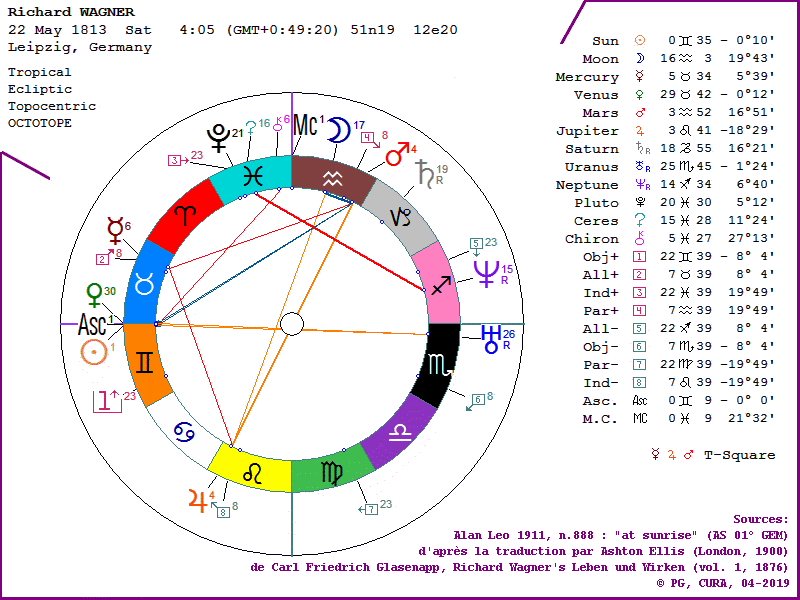
Giuseppe Verdi (1813) ⇒ BC Busseto⇒ chart
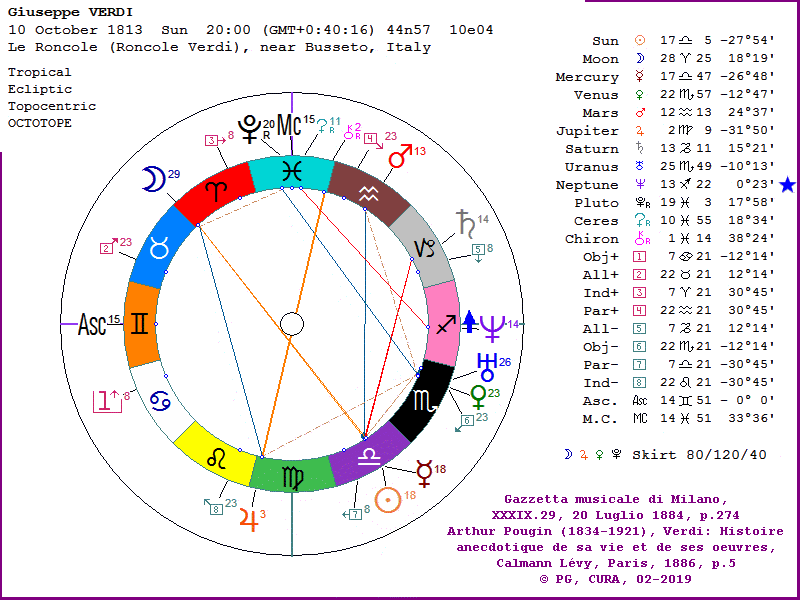
Johannes Brahms (1833) ⇒ chart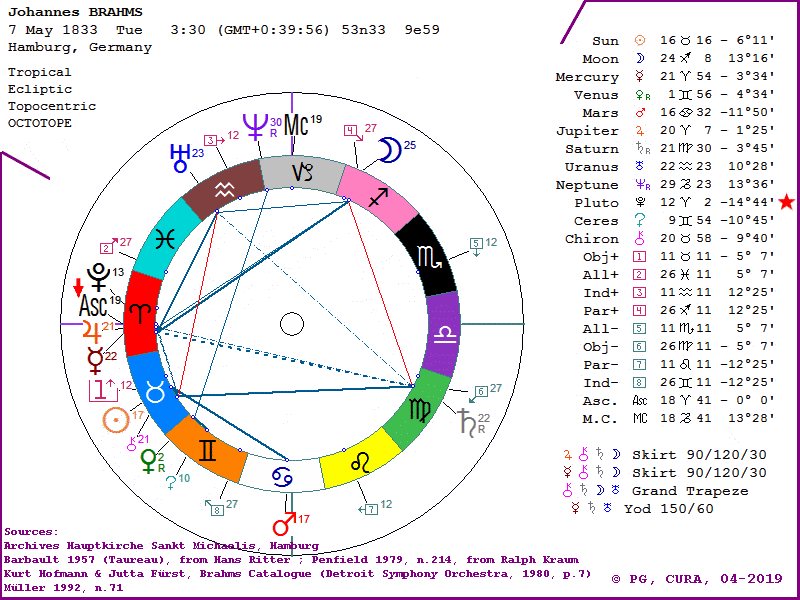
Piotr Ilitch Tchaikovsky (1840) ⇒ chart
Giacomo Puccini (1854) ⇒ chart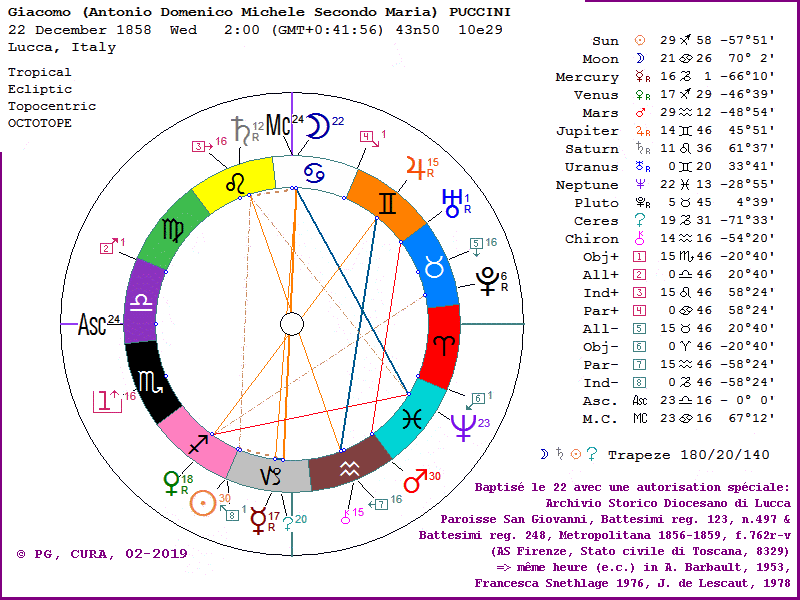
Arvo Pärt (1935) ⇒ chart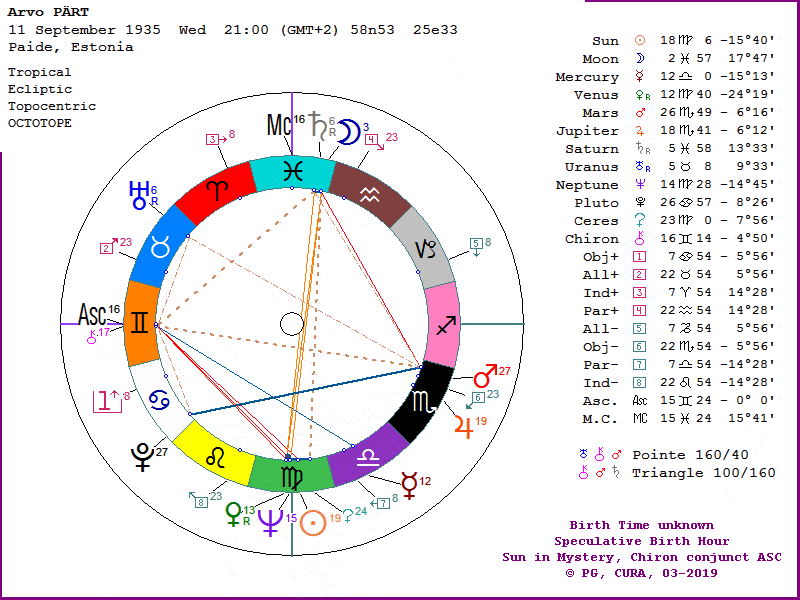
Maria Callas (1923) ⇒ chart
7. SONGS, POP, ROCK, BLUES, JAZZ
Édith Piaf (1915) ⇒ chart
Sarah Vaughan (1924) ⇒ chart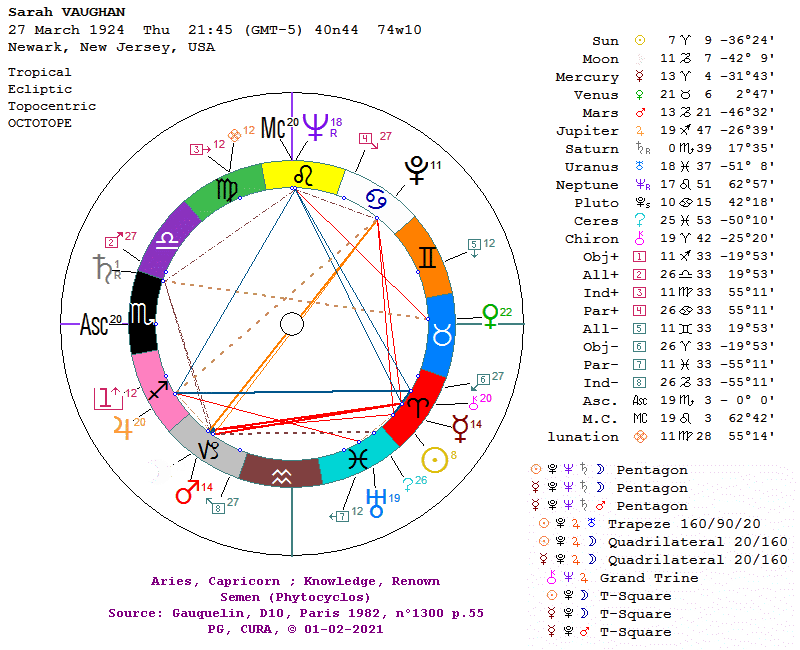
Jacques Brel (1929) ⇒ chart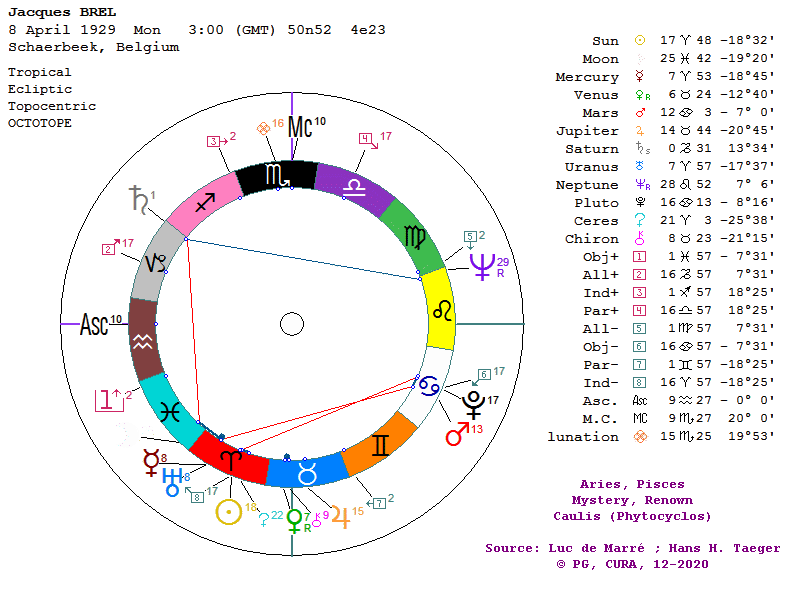
Claude François (1939) ⇒ chart
Jacques Higelin (1940) ⇒ chart
Cesária Évora (1941) ⇒ chart
Janis Joplin (1943) ⇒ chart
Salvatore Adamo (1943) ⇒ chart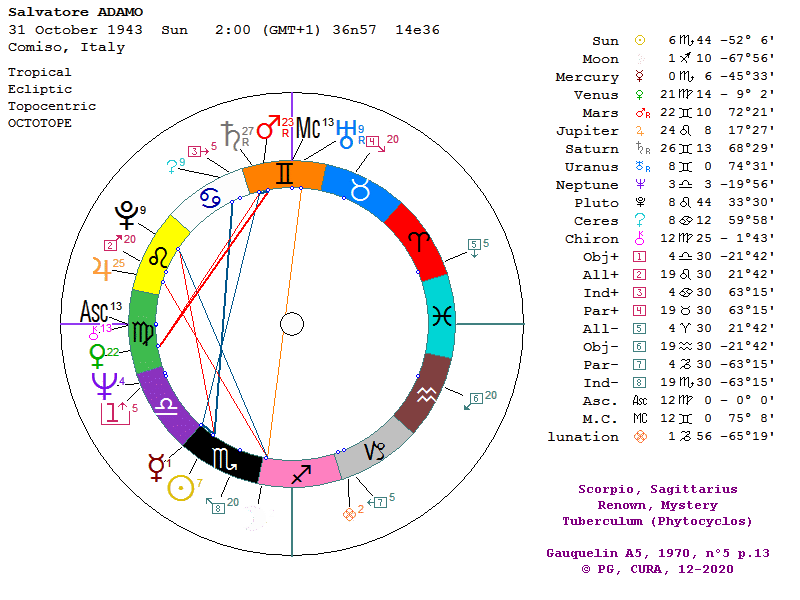
Michel Polnareff (1944) ⇒ chart
Elodie Vanda Frégé (1982) ⇒ chart
Katie Melua (1984) ⇒ chart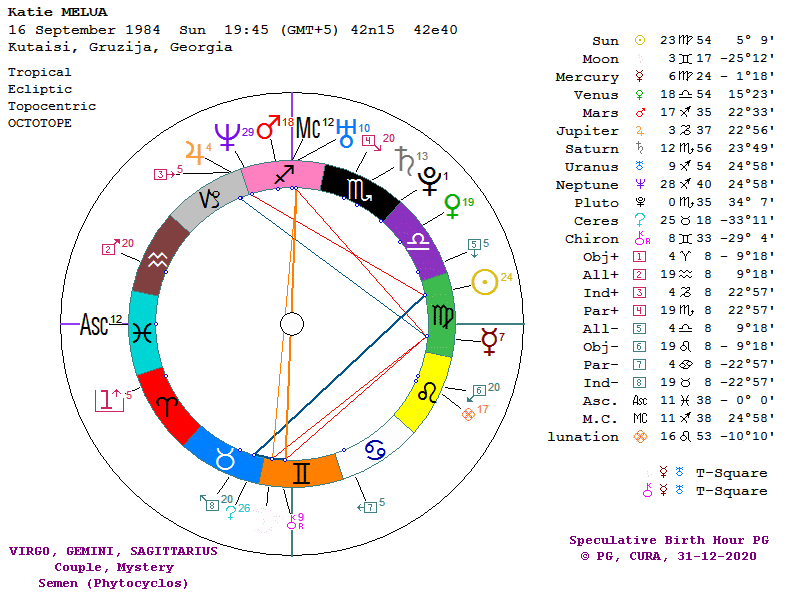
8. CINEMA
David Griffith (1875) ⇒ Stars1918⇒ chart
⇒ CA4
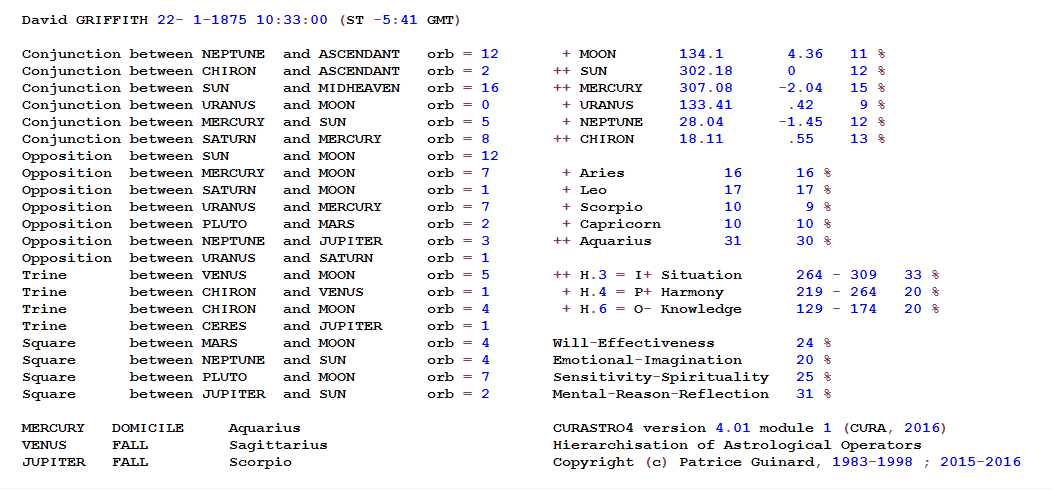
Carl Theodor Dreyer (1889) ⇒ chart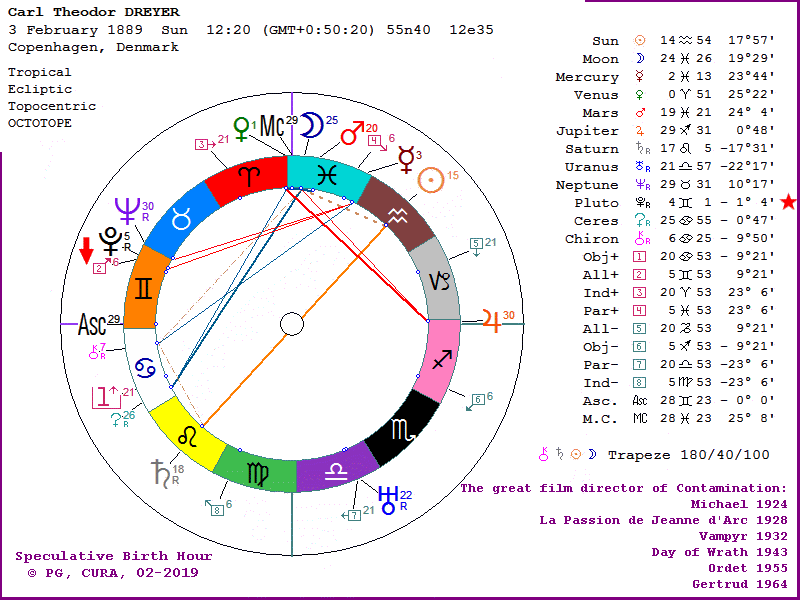
Charles Chaplin (1889) ⇒ MC ; chart⇒ CA4

Fritz Lang (1890) ⇒ chart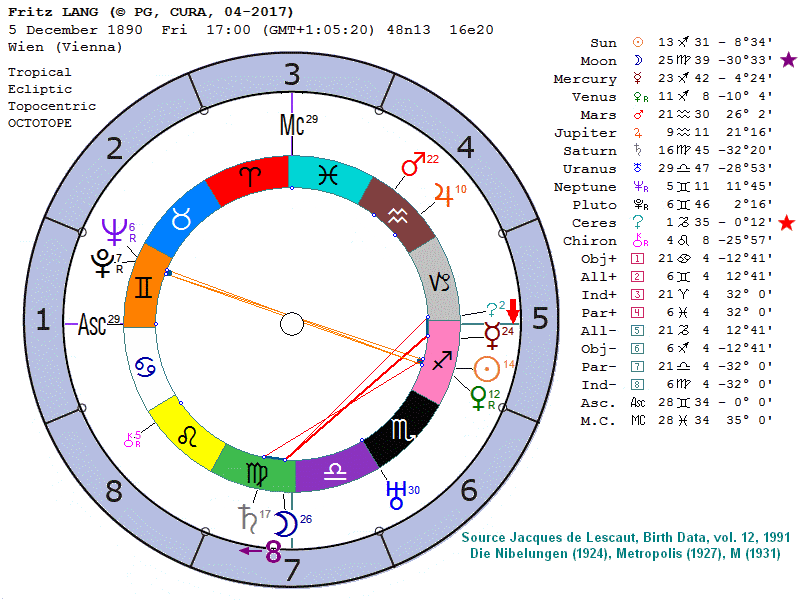
Luchino Visconti (1906) ⇒ chart⇒ CA4

Akira Kurosawa (1910) ⇒ chart
Marguerite Duras (1914) ⇒ BC extr.⇒ chart
⇒ CA4

Jacques Rivette (1928) ⇒ chart⇒ CA4
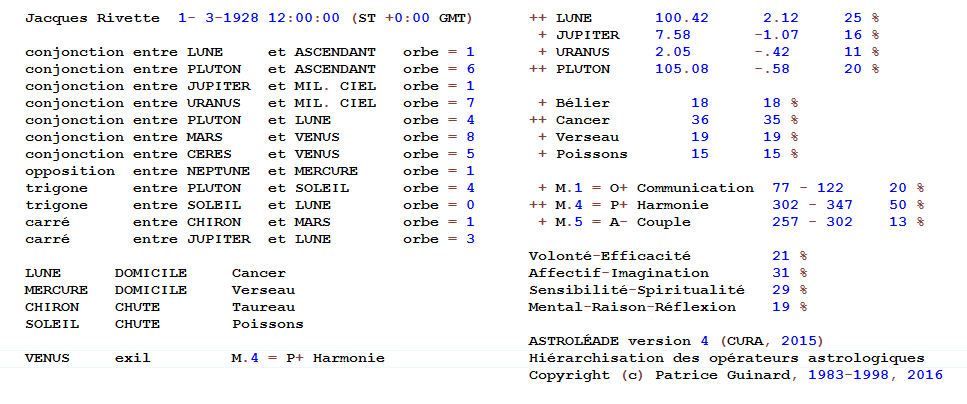
Jean-Luc Godard (1930) ⇒ chart
Andrei Tarkovsky (1932) ⇒ chart
Carmelo Bene (1937) ⇒ chart⇒ CA4
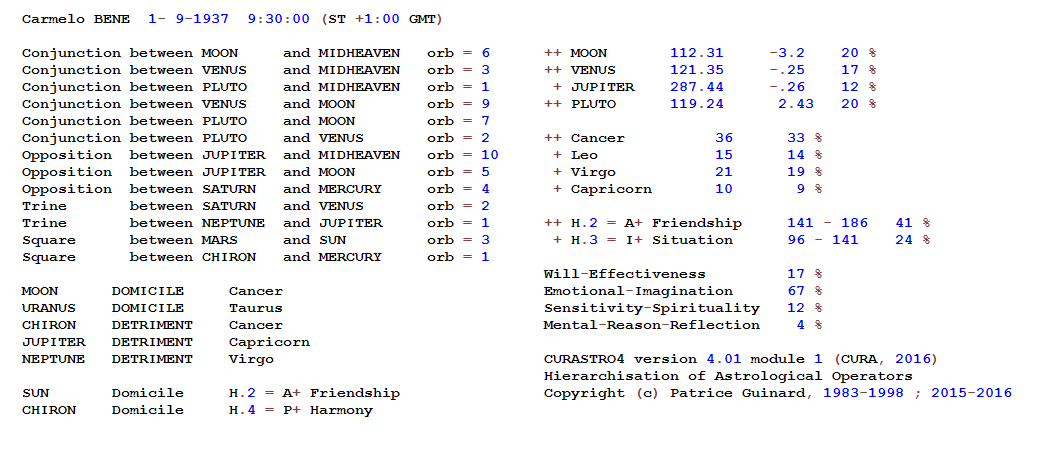
Béla Tarr (1955) ⇒ chart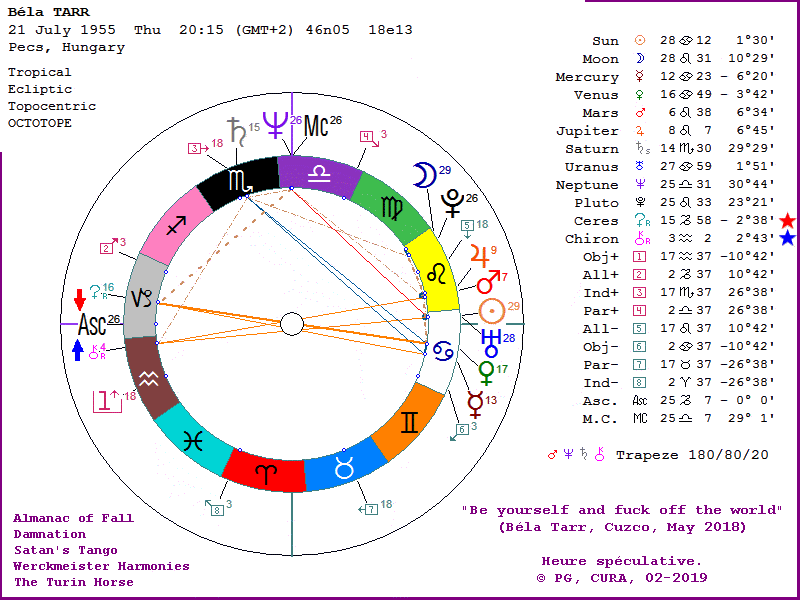
9. SOVEREIGNS, MILITARIES
The First Roman Emperors (8 charts)
Julius Caesar (100 BC) ; Augustus (63 BC ; see also CN 226 ; Tiberius (42 BC)
Claudius (10 BC) ; Vespasianus (9 AD) ; Caligula (12 AD) ; Nero (37 AD) ; Domitianus (51 AD)
Valeria Messalina (19 BC) ⇒ chart⇒ CA4
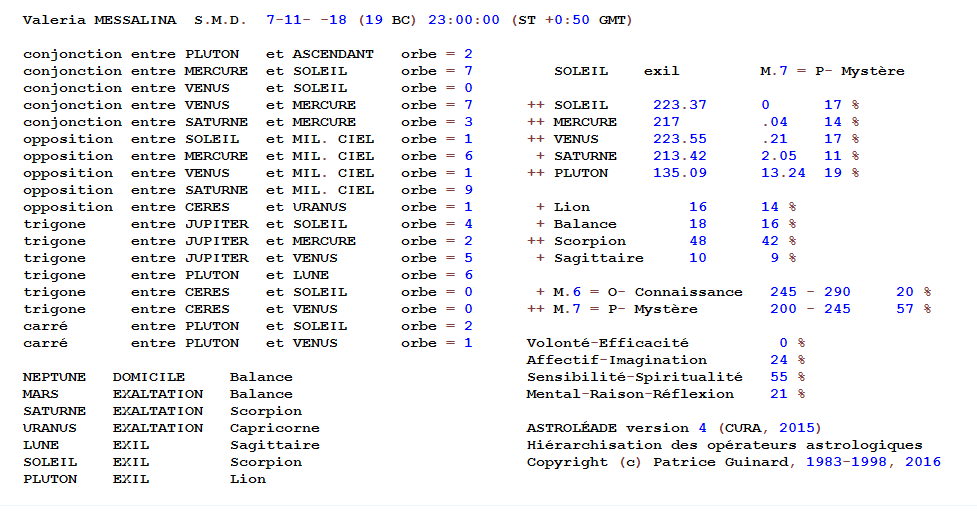
Publius Aelius Hadrianus (76 AD) ⇒ chart
Guillaume IX d'Aquitaine (1071) ⇒ chart
Raymond VI (1156) ⇒ Toulouse ; chart⇒ CA4

Philippe IV le Bel (1268) ⇒ chart
Joan of Arc (1413) ⇒ Rodden ; chart⇒ CA4

Nicolaus Gugler's Horoscopes (18 charts)
Frederick III (1415) ; Casimir IV Jagiellon (1427) ; Vladislaus II of Hungary (1456) ; Maximilian I (1459)
Frédéric III de Saxe (1463) ; Georges de Saxe (1471) ; Christian II de Danemark (1481) ; Ulrich VI de Wurtemberg (1487)
Albert of Brandenburg (1490) ; Henry VIII of England (1491) ; François Ier (1494) ; Charles V (1500)
Jean-Frédéric Ier de Saxe (1503) ; Ferdinand Ier de Habsbourg (1503) ; Philippe Ier, dit le Magnanime (1504)
Jean-Ernest de Saxe-Cobourg (1521) ; Maximilian II of Habsbourg (1527) ; Felipe II de España (1527)
The Valois : cf. CORPUS NOSTRADAMUS 215 (8 charts)
Henry II (1519) ; François II (1544) ; Elisabeth de Valois (1545) ; Claude de Valois (1547)
Charles IX (1550) ; Henry III (1551) ; Marguerite de France (1553) ; François d'Alençon (1555)
Henry IV (1553) ⇒ chart
Oliver Cromwell (1599) ⇒ chart
Nicolas Fouquet (1615) ⇒ chart
Jean-Baptiste Colbert (1619) ⇒ chart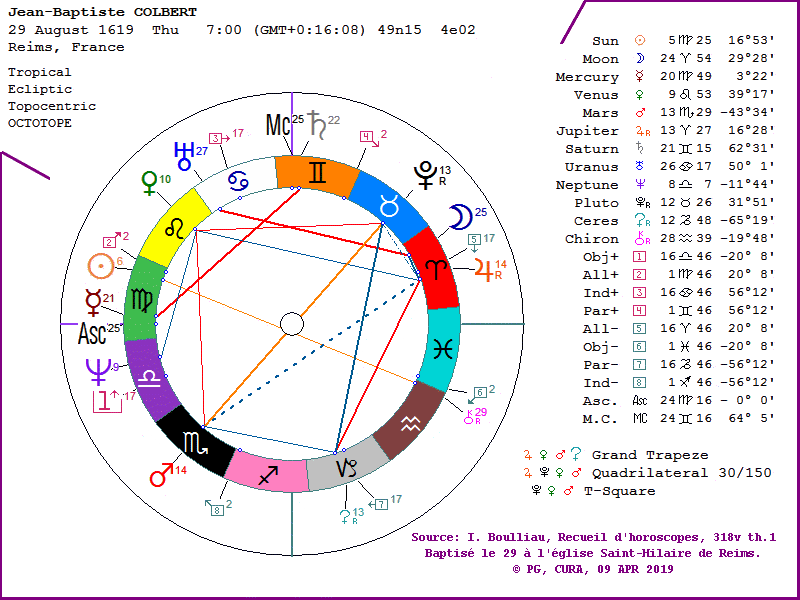
Louis XIV (1638) ⇒ CN 226 ; chart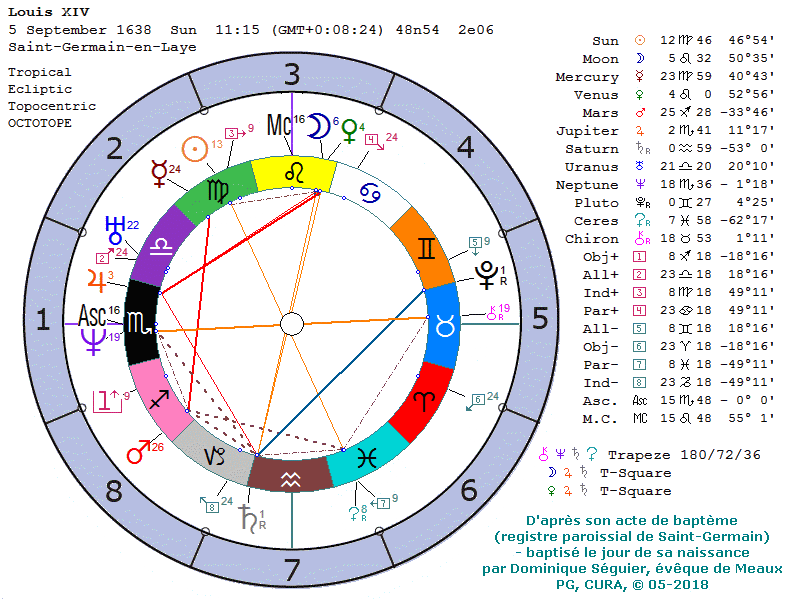
Napoléon (1769) ⇒ Baptème⇒ chart
⇒ CA4

Charles de Gaulle (1890) ⇒ chart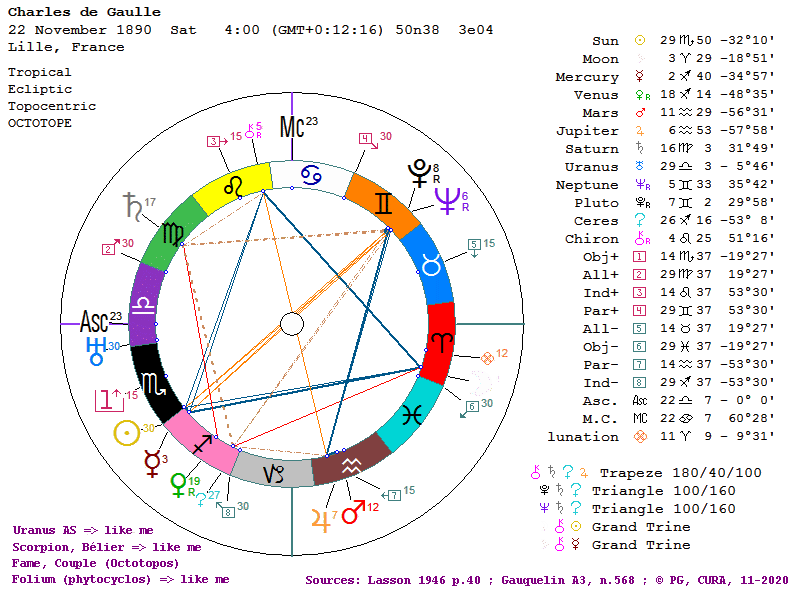
Vladimir Putin (1952) ⇒ chart
10. SPORT
Ourasi (1980) ⇒ chart⇒ CA4

11. CHESS
cf. CHESS CHAMPIONS DATABASE (14 players)
Emanuel Lasker (1868) ; José Raúl Capablanca (1888) ; Alexandre Alekhine (1892) ; Max Euwe (1901)
Bobby Fischer (1943) ; Anatoly Karpov (1951) ; Jan Timman (1951) ; Garry Kasparov (1963) ; Boris Gelfand (1968) ; Viswanathan Anand (1969)
Etienne Bacrot (1983) ; Maxime Vachier-Lagrave (1990) ; Magnus Carlsen (1990) ; Fabiano Caruana (1992)
12. BOARDGAMES DESIGNERS
cf. BOARDGAMES DESIGNERS ASTRO PROJECT and Boardgames Designers Charts (39 designers)
Albert Emmanuel Lamorisse (1922) ; David Parlett (1939) ; Tom Dalgliesh (1945) ; William Caveny Eberle (1945) ; Christian Freeling (1947) ; Urs Hostettler (1949)
Marco Alberto Donadoni (1951) ; Mark Herman (1954) ; François Xavier Nédelec (1954) ; Richard Breese (1956) ; Kris Burm (1957) ; Reiner Walter Knizia (1957)
Dominique Ehrhard (1958) ; Roberto Fraga (1960) ; Frédéric Bey (1961) ; Richard Channing Garfield (1963) ; Andrew J. Looney (1963) ; Bruno Cathala (1963)
Roberto di Meglio (1966) ; Vital Lacerda (1967) ; Christophe Boelinger (1967) ; Virginio Gigli (1968) ; Jason Matthews (1970) ; Stefan Feld (1970)
Pierluca Zizzi (1970) ; Sébastien Pauchon (1971) ; Paulo Soledade (1975) ; Markus Brand (1975) ; Inka Brand (1977)
Tim Fowers (1977) ; Keith Matejka (1978) ; Antoine Bauza (1978) ; Régis Bonnessée (1979) ; Kristian Amundsen Østby (1980)
Nuno Bizarro Sentieiro (1980) ; Seiji Kanai (1980) ; Isaac Childres (1982) ; Viktor Péter (1985) ; Martino Chiacchiera (1993)
13. Moments, Cycles
Square Mars Uranus to Saturn Sun Jupiter (2020) ⇒ chart
JUP SAT Great Conjunction (2020) ⇒ chart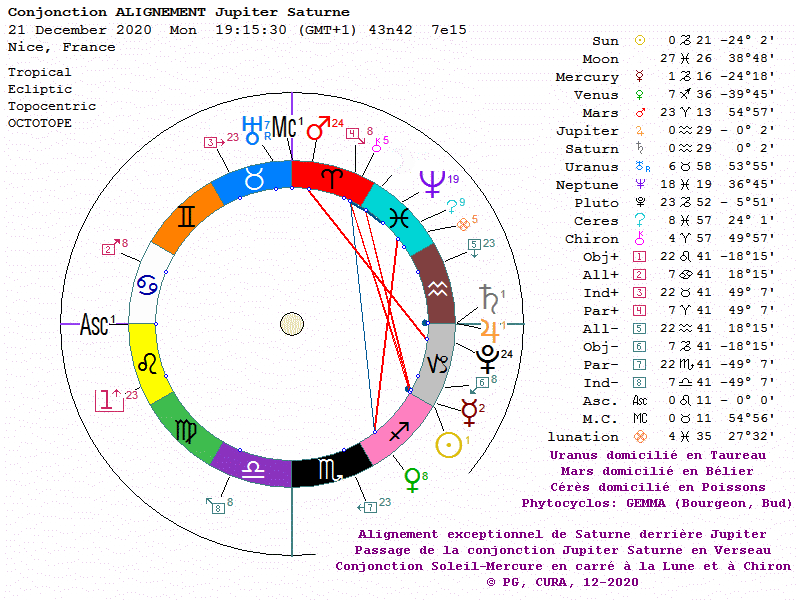
Coronavirus III (2020) ⇒ chart
Coronavirus II (2020) ⇒ chart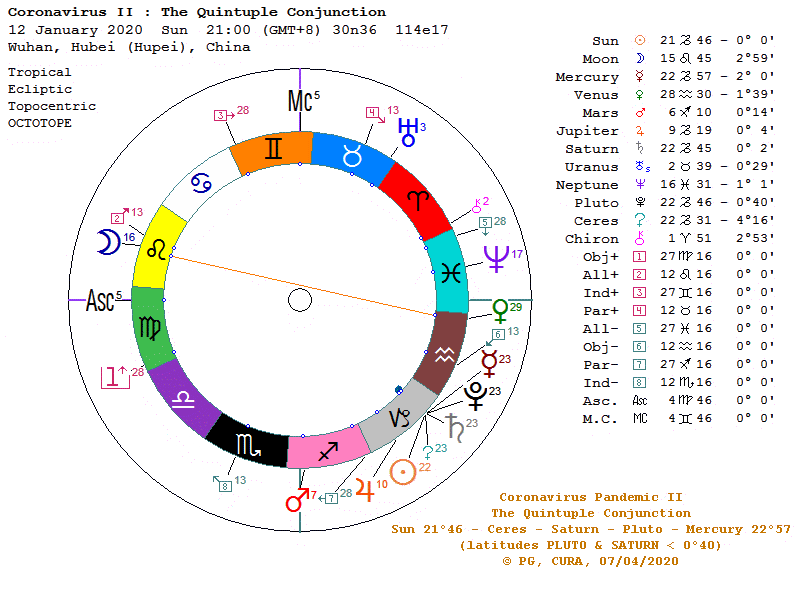
Coronavirus Birth (2019) ⇒ chart
Notre-Dame de Paris in flames (2019) ⇒ chart
Ingress Charts and New Moons (Oct. 2015 - Oct. 2016) - 22 charts
Sun in ♏ 2016 ; Sun in ♎ 2016 ; New Moon in ♍ SEP 2016 ; Sun in ♍ 2016 ; Sun in ♌ 2016 ; New Moon in ♋ JUL 2016
Sun in ♋ 2016 ; New Moon in ♊ JUN 2016 ; Sun in ♊ 2016 ; New Moon in ♉ MAY 2016 ; Sun in ♉ 2016 ; New Moon in ♈ APR 2016
Sun in ♈ 2016 ; Sun in ♓ 2016 ; Sun in ♒ 2016 ; New Moon in ♑ JAN 2016 ; Sun in ♑ 2015
New Moon in ♐ DEC 2015 ; Full Moon NOV 2015 ; Sun in ♐ 2015 ; New Moon in ♏ NOV 2015 ; Sun in ♏ 2015
Lunar Quarters 2011-2012 (12 charts ; partial translation)
New Moon in ♓ FEB 2012 ; Full Moon FEB 2012 ; New Moon in ♒ JAN 2012 ; Full Moon JAN 2012
First Quarter JAN 2012 ; New Moon in ♑ DEC 2011 ; Full Moon DEC 2011 ; New Moon in ♐ NOV 2011
Last Quarter NOV 2011 ; Full Moon NOV 2011 ; New Moon in ♏ OCT 2011 ; Premier Quart APR 2011
Corpus Nostradamus (2006, 1er Fev) ⇒ CN 01 ; chart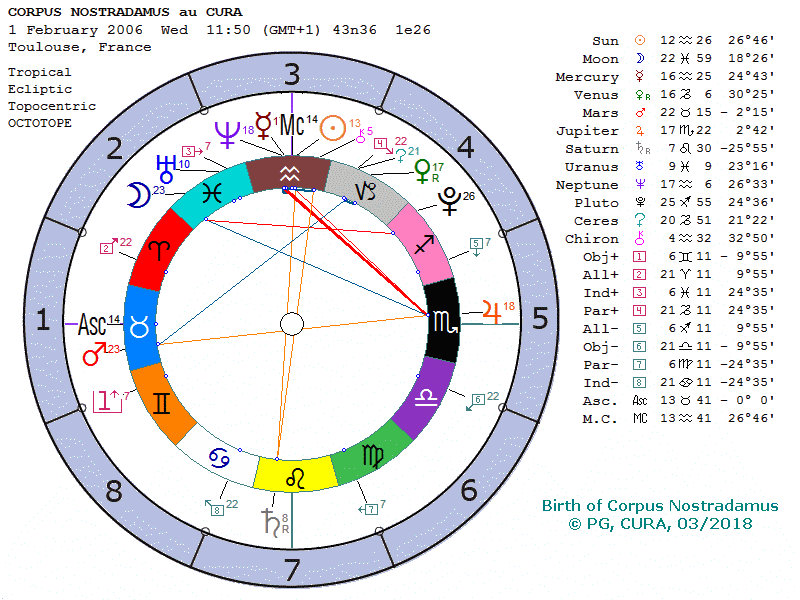
11 Harmonic Patterns (2003, 8 Nov) ⇒ chart
Founding of CURA (1999, 1er Nov) ⇒ CURA ; chart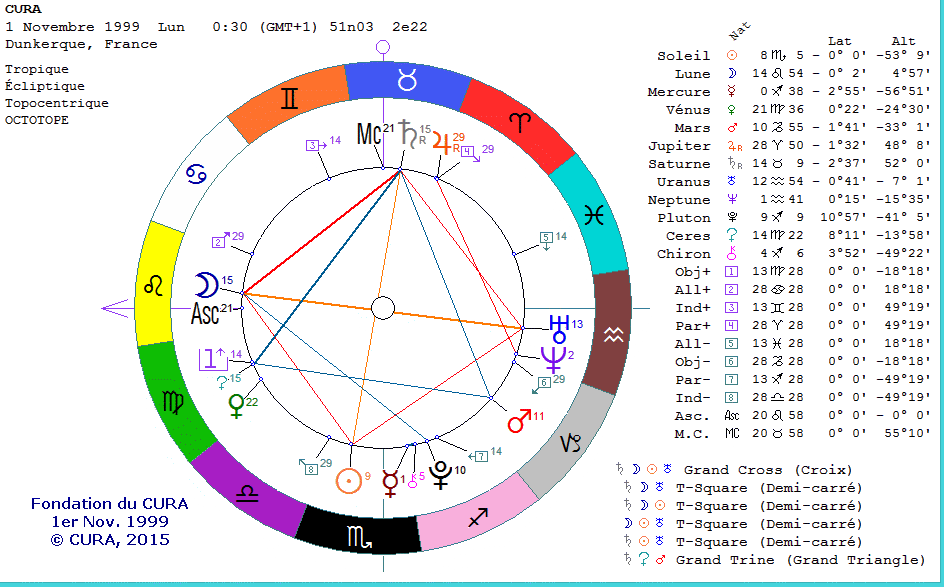
CHIRON (1977, 1er Nov) ⇒ chart
PLUTO (1930, 23 Jan) ⇒ CN 84 ; chart
NEPTUNE (1846, 8 Aou) ⇒ CN 84 ; chart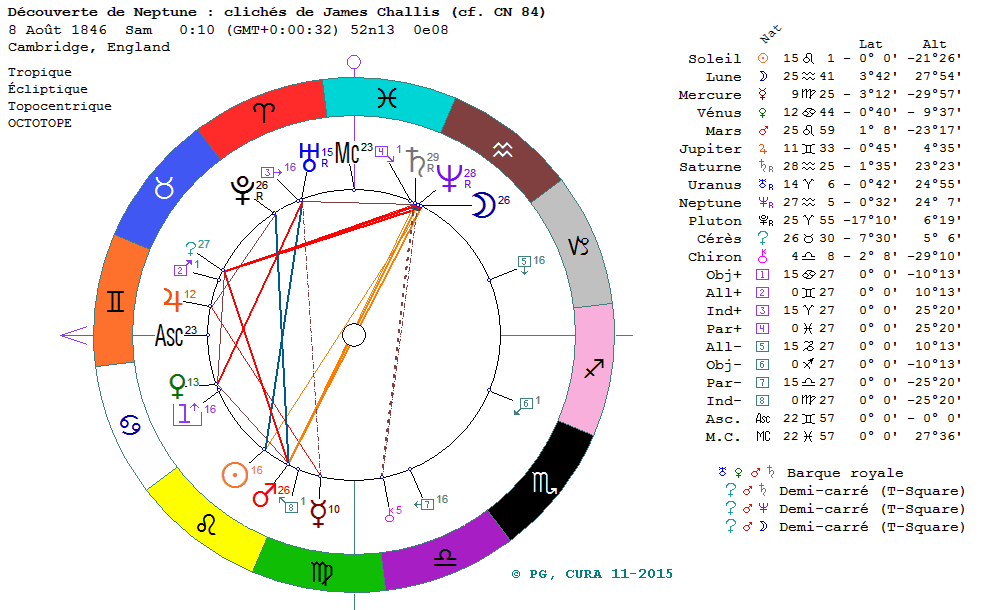
CERES (1801, 1er Jan) ⇒ ⇒ MC ; chart
URANUS (1781, 13 Mar) ⇒ CN 84 ; chart
Chaldeans in Babylonia (964 BC) ⇒ Thema Mundi ; chart
Kali Yuga (3102 BC) ⇒ Tropical⇒ Sidereal Lahiri
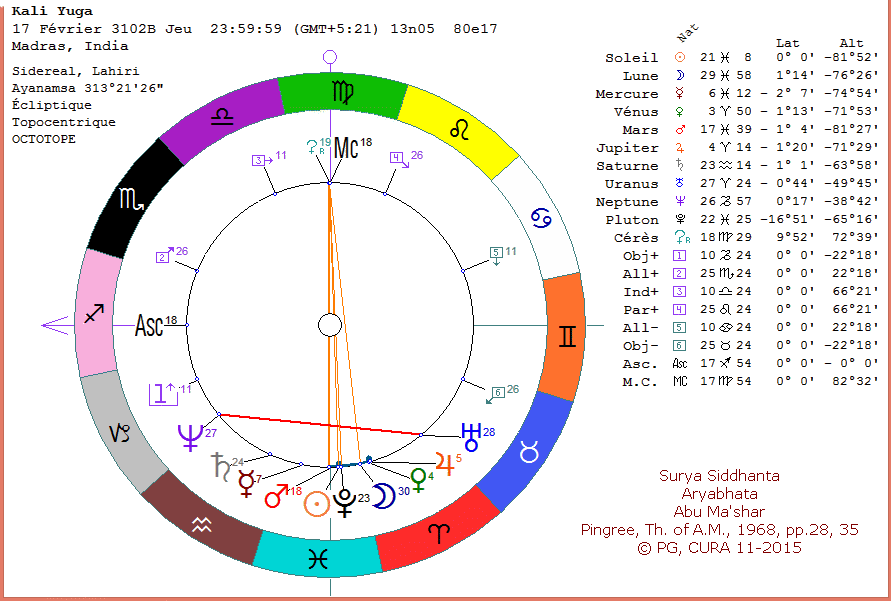
CURA's Charts and CurAstro4 Analysis
http://cura.free.fr/charts/1602chartsEN.html
http://cura.free.fr/charts/1511charts.html (French version)
translation 19-02-2016 ; updated 01-02-2021
All rights reserved © 2015-2021 Patrice Guinard
Centre Universitaire de Recherche en Astrologie
Web site Designer & Editor: Patrice Guinard
© 1999-2021 Dr. Patrice Guinard